
“Every good hunter is uneasy in the depths of his conscience when faced with the death he is about to inflict on this enchanting animal.”
~ Jose Ortega y Gasset
In Hunting Retriever magazine, Rich Carpenter discussed why some people run their dogs in hunt tests. And yet they don’t hunt.
I’d like to expand on that a bit and ask, Why did you choose a retriever if you don’t hunt? There are lots of other breeds and many make sweet and loyal companions.
Why choose a retriever?
If you own a retriever and don’t hunt, are you doing your dog a disservice?
I remember the first time my dog, Chip, retrieved a freshly killed bird. He brought it back to me with a look that plainly said, “Wow! THIS is what I was meant to do!” He had retrieved many things before, but this time it was different. His instincts had kicked in.
He would still retrieve balls and frisbees, but he loved retrieving birds.
Have you considered learning to hunt?
Speak up if you would like to hunt, but don’t know how to or where to go. Many hunters are passionate about their sport and would be glad to talk to you about it. If you have a good attitude and a sincere desire to learn, you might be able to talk one of them into an invite on one of their hunts.
But maybe you don’t hunt because you might have to kill something. And you don’t want to do it. I understand. Many hunters feel a pang when they’ve killed an animal or a bird, but it is the way of nature.
We are so far removed from our food, that we often forget those steaks we bought were once a cow. A peaceful, grass-eating animal. We don’t think about that because we didn’t participate in killing that animal or cutting it into pieces to store in our refrigerator.
And that’s okay. The cows and pigs and chickens on display in the grocery store were bred and raised for exactly that.
Wild game is different
On the other hand wild game often die a violent death – sometimes being eaten alive. Or it could be injured and, if unable to fend for itself, die a slow death from starvation.
As hunters, we owe it to the game we hunt, to provide a quick, clean death. But when the shot goes awry and a bird is injured, a well-trained retriever is the best bet to find that bird and save it from a painful, lingering death.
Why we hunt
Do we always kill when we go hunting? No, and that’s part of the fun of it. When the birds just aren’t flying, we still get to watch the rosy hues of sunrise with our 4-footed friend. Or maybe the birds are flying, but zig just as we shoot and miss. Then the dog gives us that astonished glance that questions why we would do that when he is ready to go.
Rich Carpenter quoted more from Gassett, “One does not hunt in order to kill; on the contrary, one kills in order to have hunted… with all the extras that this carries with it: the immersion in the countryside, the healthfulness of the exercise, the distraction from his job.”
So many things you miss by not getting out in the field with your dog. Think about it!
Header image courtesy TheOtherKev via Pixabay
A friend’s dog had a bad reaction to Advantix II, one of several types of topical flea and tick products. She lives in an area with lots of ticks and had used the product for years without a problem.
But recently her dog became agitated and anxious. He ran around the yard like he was panicked, hid in the bathroom and behind a table.
He’d just had a dose of Advantix II the evening before.
When she called the Advantix emergency number, she was told “it feels like tiny needles and burning all over his skin.” She bathed him with a degreasing soap (Dawn) and gave him some Benadryl. Luckily the dog is doing fine now.
What you should know
Advantix II can cause:
- skin irritation such as redness, scratching, or other signs of discomfort
- gastrointestinal signs such as vomiting or diarrhea
- lethargy or agitation
- sensation of burning, tingling, itching, redness or numbness of the skin
If you search on ‘Advantix II Paresthesia’ you’ll find several cases where dogs have had a bad reaction.
Also keep cats away from treated dogs for 24 hours. Cats can’t metabolize some compounds in tick products which may cause serious health issues.
Someone who replied to her post, suggested avoiding Nexgard because her friend’s dog started seizing after using it. That dog died.
Another reply talked about a dog that “started having grand mal seizures. Over time they got worse and started clustering.” They traced the reaction to Frontline, and the seizures stopped when they stopped using Frontline.
Yet another reply said she “used K9 Advantix one time and my girl had a stroke from it!!”
Bravecto is another product that was discussed. Some people like it, but it’s suspected of causing sterility.
Bottom line?
Be very careful of chemicals used on your dog. Flea and tick products are designed to spread and coat the whole body. Although that may help prevent fleas and ticks, it could cause health issues.The skin is the body’s largest organ and plays a big role in the maintenance of health.
Instead, check your dogs when they’ve been in a tick-filled area and pull any ticks off manually.
One product I use with good results is Dyna Shield. It’s a blend of essential oils, herbs and plant extracts and can be used on people, dogs, cats and horses. Click to learn more about Dyna Shield and other products from Dynamite Specialty Products.
If you must use some sort of chemical, check out diatomaceous earth. I haven’t used it, but I’ve heard it has good results with few to no side effects.
Originally posted June 11, 2018.
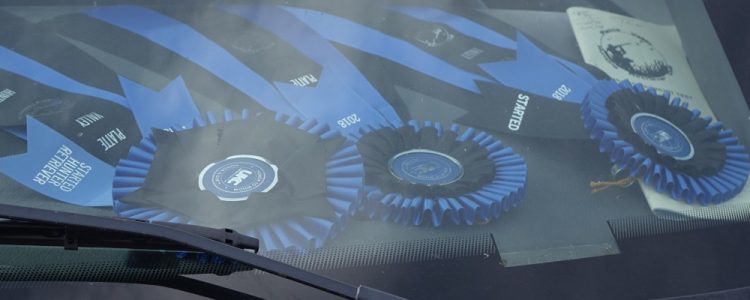
Completing Tisket’s hunt test title
We ran in the hunt test at Indian Meadows in Snyder, Colorado. Tisket only needed two passes to complete her Started hunt test title (SHR), so she was entered both days.
The first land mark on Saturday was in fairly heavy cover and a bit shorter than what we’d practiced. Many dogs, including Tisket, overran the mark and had to work their way back, while honoring their noses. Tisket ran back and forth where she thought the bird had dropped, to try to pick up the scent. You could tell when she caught the scent because her nose looked like it had been snagged by a fishhook.
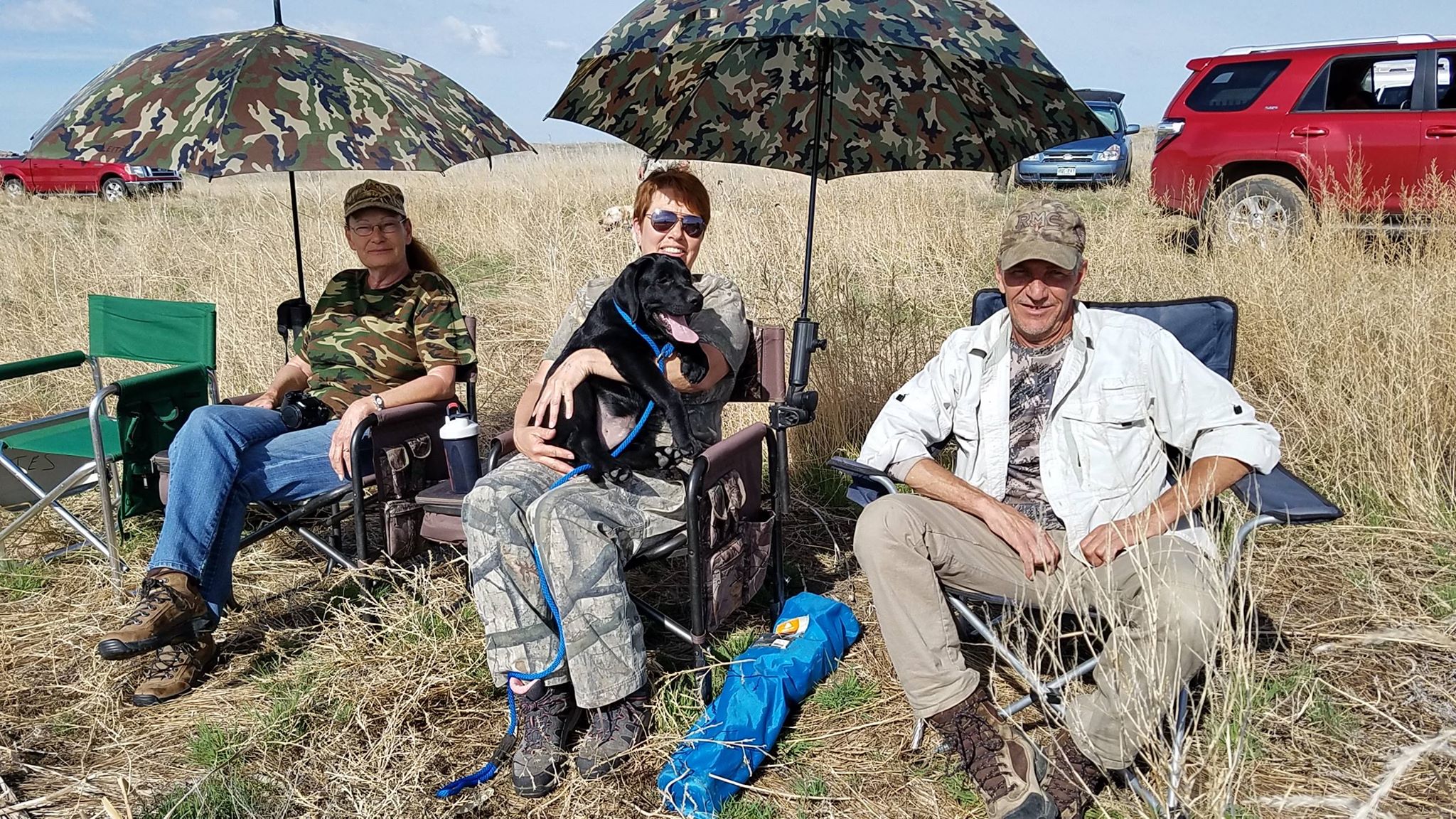
She ran straight to the second mark – “stepped on it” – and brought the bird back to me. The land marks were done, next up were the water marks!
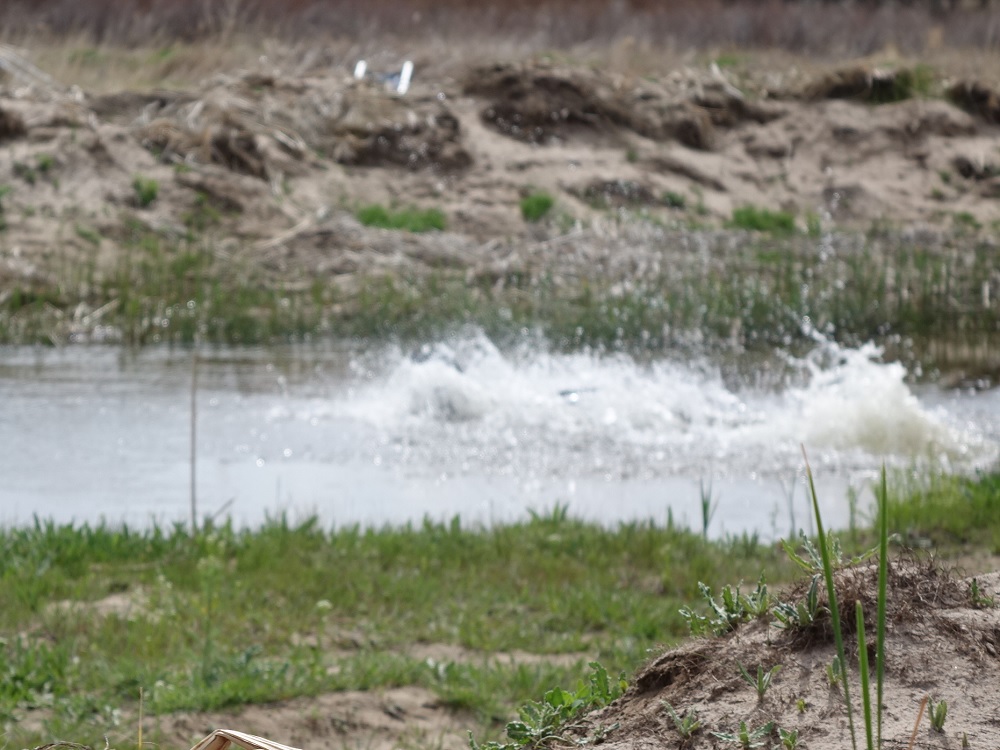
The water marks were set up at the end of a spit of land. The first mark was across a channel into a marshy area to give a slight splash when the birds landed. The second mark was to the left in open water on a good-sized pond.
Tisket did great on the first mark, except she had to check the decoys on the way back. She never dropped her bird, but had to bump each decoy with her nose to make sure it wasn’t real.
The open water swim was out and back, despite the slight chop due to the wind.
Another pass for Tisket!
Wynk’s first hunt test
On Sunday we started with the water marks and Tisket’s daughter, Wynk, got to run for the first time.
Both marks were across a channel – wider than yesterday’s location – and onto a sandy bank with sparse grass.
Tisket was out and back quickly on both birds. Very nice retrieves.
Wynk came out raring to go! There wasn’t room for a running start, but she leaped into the water with a big entry and picked up each bird in turn. No time wasted hunting around – she knew exactly where her birds were.
On to the land marks for both girls!
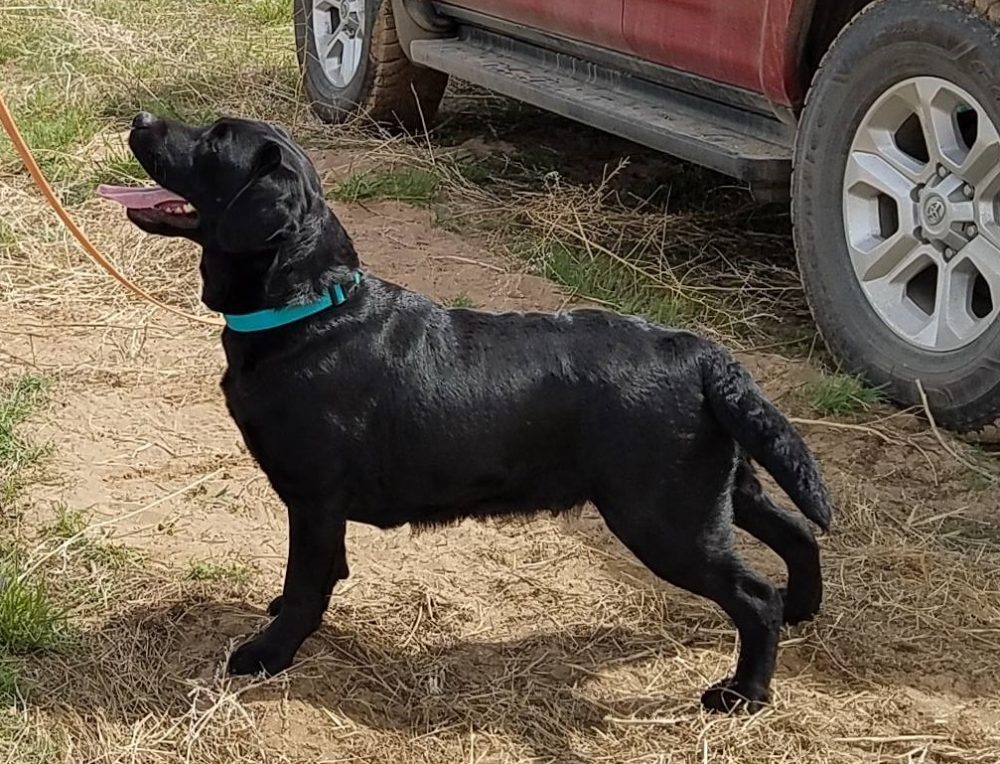
It was hot and starting to get muggy with a thunderstorm brewing to the west. Didn’t bother either girl in the least.
Tisket ran first again. Out, scoop up the bird and back in no time. The second bird landed in a little swale and she overran it by a yard or two. But she turned quickly, scooped it up and brought it back to me. No question she picked up another pass and that was enough for her title!
Wynk came out raring to go again. Good, because I was wilting with the heat and humidity. Although she’s not very tall, she motored her way to each mark and surprised a few people with her speed. Out and back quickly on the first mark. Slide and turn as she tried to pick up the second bird without stopping. No question; she likes this game!
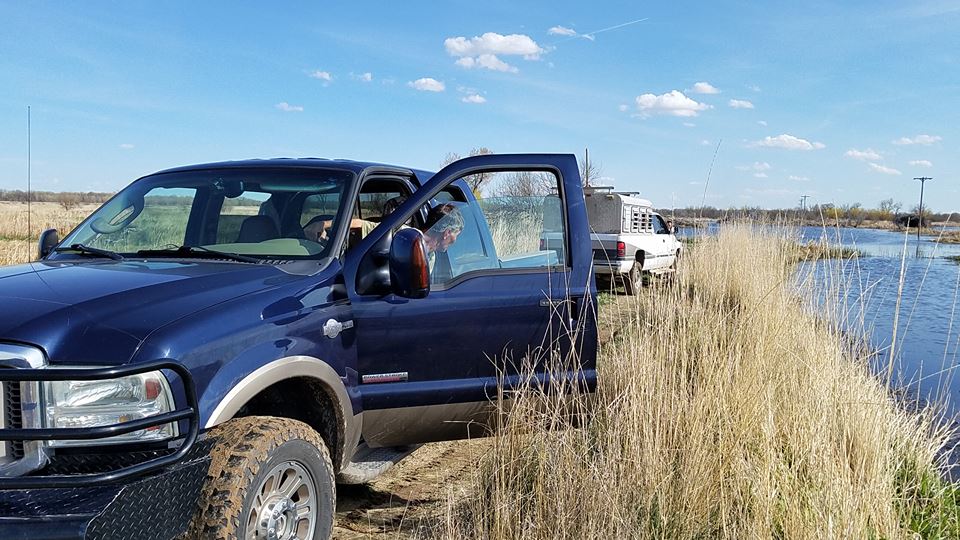
Overall, great weekend.Platte Valley HRC’s club members, helpers, and judges did a good job.
Tisket finished her title, Wynk got her first pass and my truck didn’t stay stuck for long!
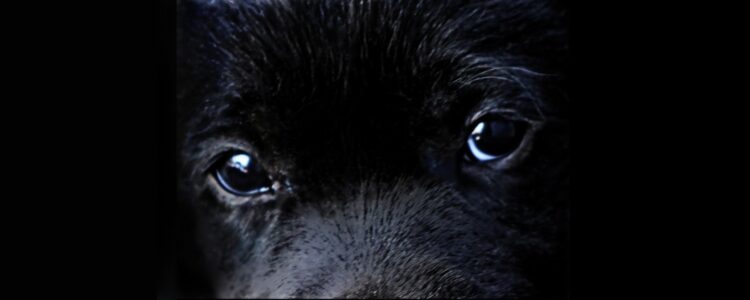
An annual eye exam can help identify problems early, but it also helps breeders make good decisions about which dogs are suitable for breeding.
Some eye problems are due to injury, some are due to age and other problems may be genetic. An eye specialist can determine the cause of a problem and provide treatment options, if necessary.
For many years the exam was known as CERF based on the Canine Eye Registration Foundation. Recently it’s changed to CAER (Companion Animal Eye Registry) which is affiliated with the Orthopedic Foundation for Animals (“OFA”).
Why it’s important
An annual eye exam should be included in every breeder’s health care plan because many eye problems are genetic and can affect puppies. Unfortunately many eye diseases have not been studied adequately due to time and funding shortages. In these cases the ophthalmologist relies on informed opinions and statistical information. Other disorders have a known genetic basis and testing can often be done by sending a cheek swab to a lab for analysis.
Puppies as young as 21 days can be examined. The exam should be repeated annually, at least through the dog’s breeding career.
Eye exams are also a good idea for dogs that won’t be used for breeding as problems are often easier to treat when they’re caught early.
Who can do the exams
These exams can only be done by a board-certified ophthalmologist.
Although your regular veterinarian has had some training in eyes and vision, unless she has had several years additional training and passed the American Board of Veterinary Ophthalmology certifying exam, she is not qualified to do these exams.
There are several ophthalmologists in the greater Denver area, a few around Fort Collins/Loveland and a couple in Colorado Springs. In surrounding states, there are none in WY, four in UT, three in NM, one in NE, and five in KS. Use the search function to find an ophthalmologist near you.
Each one sets their own price and currently they range from $45 to over $100. Another option is contacting a local dog club, particularly one that hosts dog shows. Occasionally they will also host a health clinic during the show. Many only offer eye exams, but others might offer cardiac testing, vaccinations, blood draws for heartworm and/or genetic testing. Often the testing is done at a reduced price. Because they’re popular, you need to sign up as soon as the testing is announced.
What happens during the exam?
The exams are screenings performed by board certified veterinary ophthalmologists to check for changes within the eye that indicate one or more eye diseases. The exams can be done at their office or sometimes at special clinics held at dog shows and other events.
You’ll start off by filling out a form with your information and your dog’s information including: registered name, registration number, date of birth, sex, breed/variety, permanent identification (via microchip or tattoo). An assistant will also use special eye drops to dilate the eyes. Expect dilation to last 6-8 hours. After about 15 minutes or so, you’ll meet with the ophthalmologist in a darkened room.
Note: Some breeds need to be examined before and after eye drops. They include:
- Australian Shepherd
- Dalmatian
- Louisiana Catahoula Leopard Dog
- Miniature American Shepherd
- Miniature/Toy Australian Shepherd
The exam often starts externally, looking for things such as injuries, eyelashes rubbing the cornea or growing where they shouldn’t be growing. The vet will use other equipment to magnify the interior of the eye looking for tiny anomalies in the lens, cornea and middle chamber of each eye. Then all parts of the retina are checked. Sometimes there are mirrors in the equipment that allow you to see exactly what the vet sees.
The exam generally only takes a few minutes, depending on how well your dog cooperates. Afterward you’ll get a copy of the exam form.
Eye diseases
Although there are many eye diseases that can affect dogs, very few have been adequately studied. Such studies require large numbers of related animals, sometimes several generations of dogs, and often the diseases don’t manifest until the dogs are older.
Currently there are 10 diseases with evidence that they are inherited or cause a significant problem. Signs of these diseases require an automatic fail on the eye exam.
Other diseases are presumed to be genetic, but lack a peer-reviewed study showing the mode of inheritance. These will show on the form as a “breeder option.”
Submitting to OFA
You can send the form with a small fee to OFA for certification. If your dog has passing results (including “breeder option”) you’ll get a certificate and the results will be posted on the OFA website. If the results weren’t passing, you can send those to OFA as well. There is no charge and no certificate. You can also choose whether to make those results public or not.
Certification needs to be repeated every year.
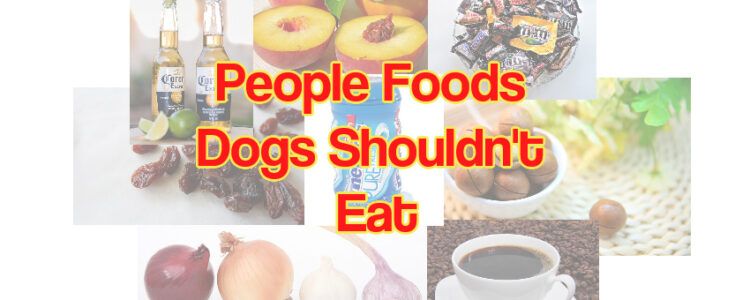
Super Bowl, March Madness and many exciting games are coming up. Do you put out snack foods and drinks so you don’t miss any of the action? If you do, I’d bet you unintentionally include some people foods dogs shouldn’t eat.
Although sometimes it seems like dogs can eat anything – yeah, even that – they really shouldn’t. Just ask your veterinarian what they’ve had to surgically remove – probably lots of socks, toys, rocks and more.
The problem is some people foods can make them sick or even die.
And unfortunately it’s not that uncommon. According to WebMD, there are “more than 232,000 pet poisoning” cases in the United States every year.
Potentially deadly foods
Dogs have different digestive systems and dietary needs than we do. So, although we might eat these foods regularly, they can be poisonous and even deadly for dogs.
- Alcohol
- Chocolate
- Coffee, tea, soda, energy drinks
- Fruit pits
- Garlic, Onion, Chives
- Macadamia nuts
- Raisins, grapes, currants
- Xylitol
If you think your dog ingested one of these items, contact your veterinarian for advice. If that’s not possible, call:
ASPCA Animal Poison Control Center
Or
The Pet Poison Helpline
There may be a fee for help from the above hotlines.
Common symptoms
Depending on what your dog ate, symptoms may start quickly or may take a few days. Here are some symptoms to watch for:
- Excessive vomiting and/or diarrhea
- Bloody urine or stool
- Inability to go to the bathroom
- Lethargy
- Irregular heartbeat
- Difficulty breathing
- Agitation
- Obvious signs of pain
- Seizures
- Collapse
If your dog ate one of the potentially deadly foods or if you see any of the above symptoms, get him to your veterinarian quickly. The sooner treatment is started, the better the chance of a good outcome.
More about potentially deadly foods
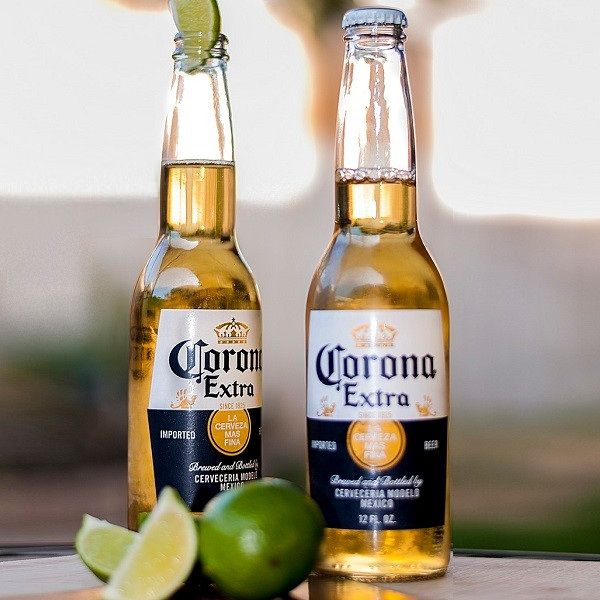
Alcohol
Some people think it’s harmless or maybe even funny if a pet gets drunk. What they fail to realize is their different metabolism, and often smaller size, makes dogs more susceptible to the effects.
Dogs seem to be more attracted to the sweeter drinks, such as eggnog, pina colada and daiquiri. However beer is also well liked.
Also be careful with foods that might contain alcohol, such as rum balls at Christmastime. And rotting or fermenting fruit, such as plums that fell from the tree, can cause similar symptoms.
Like people, dogs may be uncoordinated, may vomit or have diarrhea. At higher doses, dogs may have trouble breathing, tremors, heart arrhythmias, low blood pressure, coma and even death.
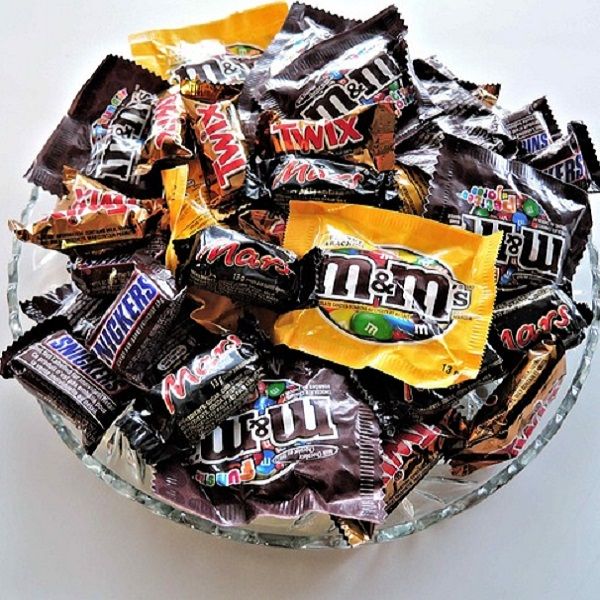
Chocolate
Yes, yummy chocolate is toxic to dogs. A substance in chocolate, called methylxanthines, contains both caffeine and theobromine. These are stimulants and can cause vomiting, diarrhea, hyperactivity, tremors, pancreatitis, irregular heart function, seizures and even death.
The darker the chocolate, the more dangerous it is for dogs, with baking chocolate having the highest levels of methylxanthines. Some chocolate products may also have other toxic ingredients, such as Xylitol or high amounts of caffeine.
Also be careful of foods that might contain chocolate – ice cream, cookies, cake and other sweets. And be aware on holidays, such as Valentines Day, Easter and Christmas, as chocolate is commonly given as gifts.
If your dog ingests any type of chocolate, even in small amounts, you need to call your veterinarian as soon as possible. Symptoms can take awhile to start – anywhere from a few hours to a day.
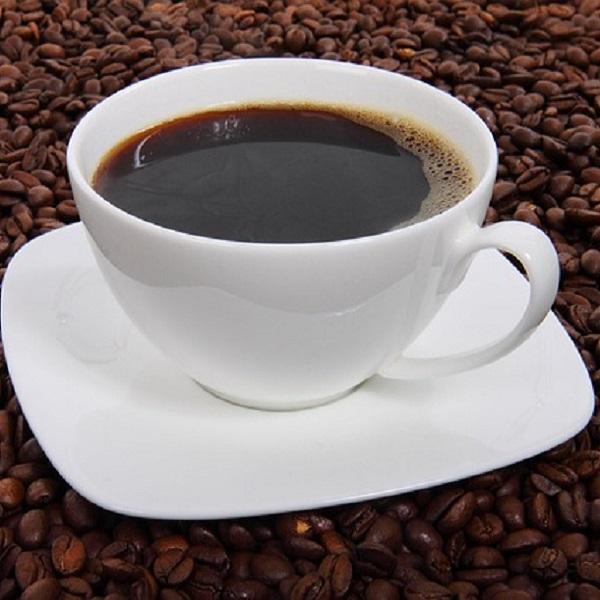
Coffee, Tea, Soda, Energy Drinks
Caffeine is the major culprit in these drinks. A small sip may not cause any harm, but ingesting a large amount can cause an increase in heart rate, abnormal heart rhythms and elevated blood pressure. Symptoms usually start within one to two hours after ingestion.
Other symptoms include vomiting, diarrhea, difficulty breathing, tremors, seizures and even death.
Pets are more sensitive to caffeine than we are. Other potential ingredients in these drinks that can cause harm are Xylitol and high levels of sugar.
Coffee grounds (often used in gardens), coffee beans, instant granules, tea bags, loose-leaf tea are all more concentrated than a sip of a drink. If your dog ingests any of these, call your veterinarian right away.
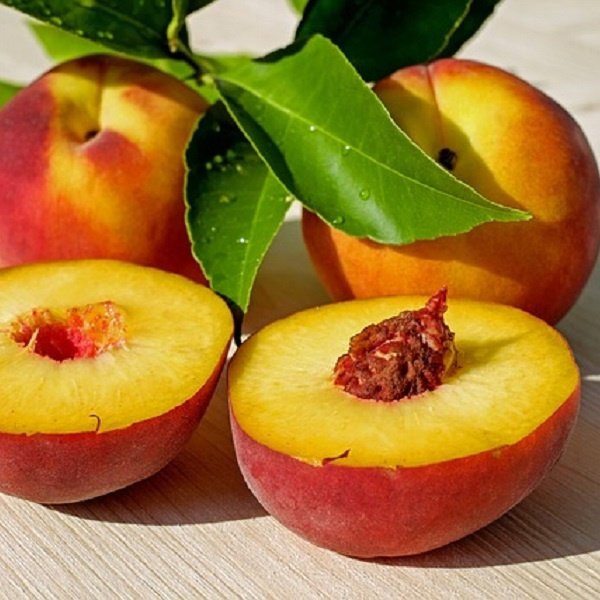
Fruit Pits
Slices of fruit are generally fine for dogs, but don’t give them whole fruit because seeds and pits contain poisonous cyanide. This includes apples, apricots, cherries, plums, peaches and other fruit with pits.
One or two apple seeds are probably not harmful, especially if they’ve been swallowed and not chewed. But what dog can resist chewing? Chewing releases the cyanide which blocks red blood cells from transporting oxygen. It’s safer for your dog if you slice and remove the core before giving it to him.
Symptoms to watch for include vomiting, panting, bright red gums, difficulty breathing, shock, dilated pupils, irregular heart beat, increased heart rate, seizures, coma and even death.
Canned and preserved fruit often have high amounts of sugar, preservatives or artificial sweeteners which can cause an upset stomach. Dried fruit, such as prunes, can also cause digestion issues.
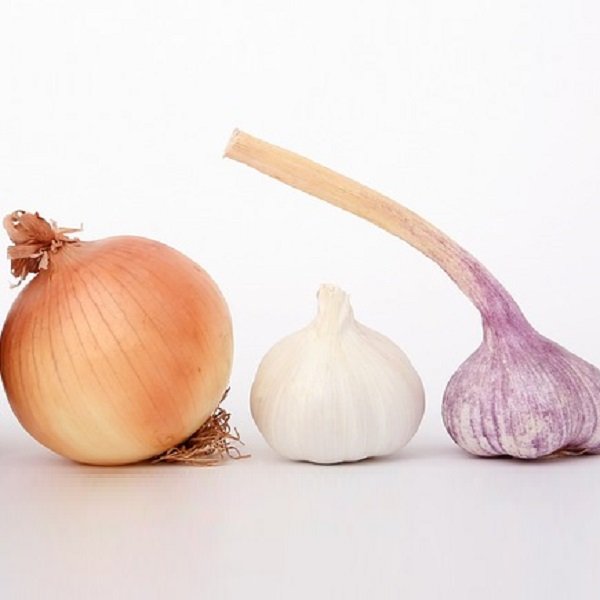
Garlic, Onion, Chives
It may be hard to believe, but plants from the Allium family – including onions, chives and garlic – are not safe for dogs to eat. They contain sulfoxides and disulfides which can damage red blood cells. Damaged red blood cells can’t carry oxygen around the body which leads to anemia.
Garlic contains higher levels of these compounds and is thus more toxic to dogs. A bite of garlic bread might not cause any problems, but raw bulbs of garlic are more concentrated and dangerous. One onion is enough to cause toxic effects. Green onions and chives are less concentrated, but can be dangerous if your dog consumes a large amount.
All parts of these plants – bulbs, leaves, juice and processed powders – are toxic to dogs.
These are also common ingredients in many prepared foods, such as pizza, spaghetti, soups, stews and various meaty dishes. Be careful with leftovers too.
Symptoms can include pale gums, weakness, excessive drooling, discolored urine, gastrointestinal irritation, vomiting, diarrhea, anemia and collapse. It may take awhile, so if you think your dog may have eaten some watch for symptoms for at least a few days.
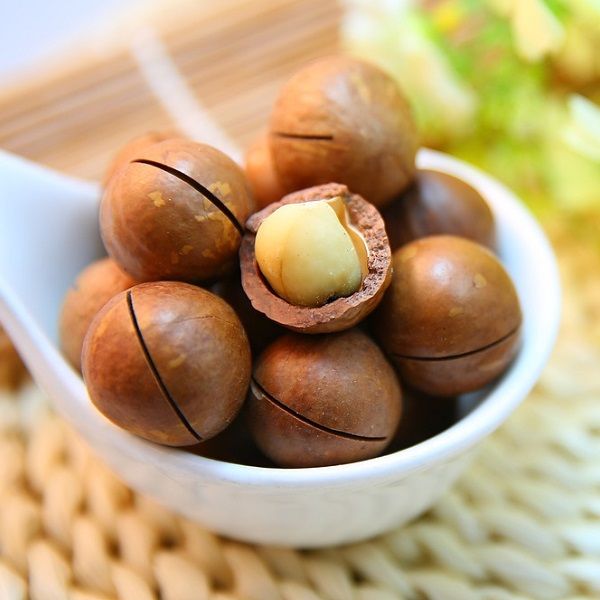
Macadamia Nuts
According to the American Kennel Club, “These are some of the most poisonous foods for dogs.”
They are a common snack food and can be found in trail mixes and baked goods. It only takes a few nuts to cause severe poisoning. However why these nuts are so toxic to dogs is unknown.
Macadamia nuts can cause depression, weakness, vomiting, abdominal pain, tremors, high fever, lethargy and inability to walk (particularly with the hind legs) and increased heart rate. Symptoms usually appear within hours after ingestion and may last for 24 to 48 hours.
If there’s a chance your dog ingested some, call your veterinarian right away.
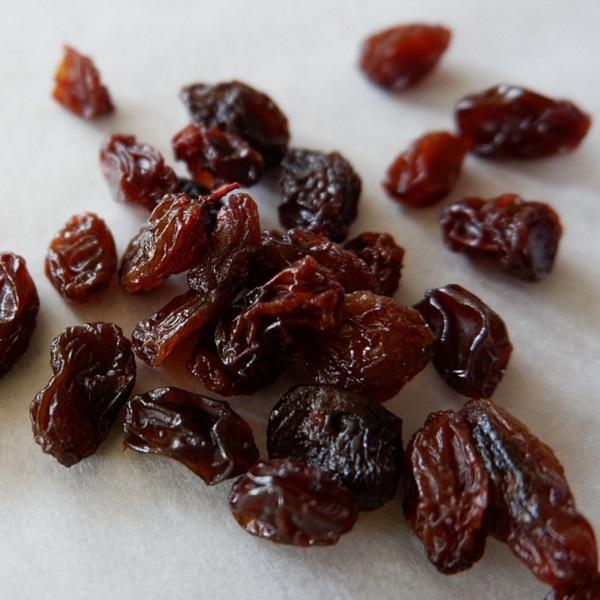
Raisins, Grapes, Currants
Although still surprising to some dog owners, raisins, grapes and currants are extremely toxic to dogs. They can cause severe liver damage and kidney failure. Some dogs have died after eating less than a handful of raisins.
Why they are so toxic to dogs is still a mystery. As is why some dogs develop severe symptoms while other dogs can ingest some and seem fine.
According to Merck, “Most dogs with raisin or grape toxicosis develop vomiting and/or diarrhea within 6-12 hours after ingestion of grapes or raisins. Other signs include lethargy, anorexia, abdominal pain, weakness, dehydration, polydipsia, and tremors (shivering).”
More severe symptoms may be seen in 24-48 hours with severe kidney damage.
Raisins are found in many baked goods, such as fruit cakes, raisin bread, bagels, cakes and cookies. They’re also in cereals and trail mixes. Grapes are made into jellies and juice. If you grow grapes or currants make sure your dog doesn’t have access to that area.
Call your veterinarian immediately if you think your dog may have eaten anything containing raisins, grapes or currants.
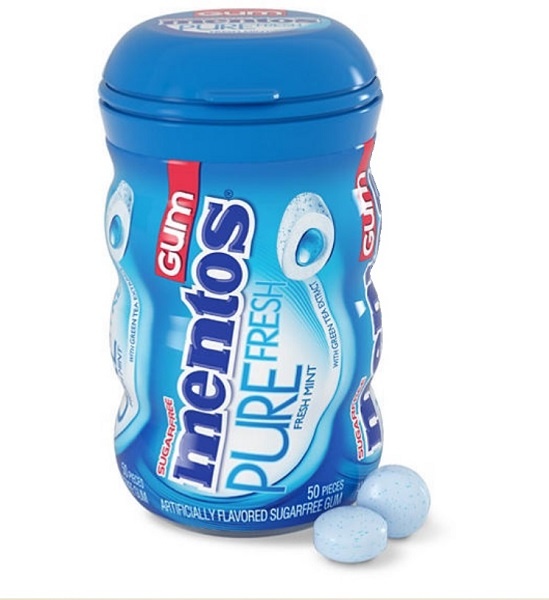
Xylitol
White sugar is bad for you. So instead food processors are making sugar-free products using a substitute originally made from wood chips or straw. It’s called Xylitol and is an ingredient in many gums, breath mints, candies, desserts, toothpastes and mouthwashes. It’s also found in pet mouth wash and oral rinses!
Unfortunately it can be deadly for dogs.
Xylitol can cause a spike in insulin, leading to a rapid drop in blood sugar levels in dogs. If sugar levels drop too low, your dog could become hypoglycemic with potentially harmful side effects. A higher dose can be life-threatening within minutes.
According to the Pet Poison Helpline, “to achieve a potentially toxic dose, a 10 pound dog would only have to eat one piece of gum!”
Reports of dog poisoning cases involving Xylitol are increasing.
Symptoms may develop within minutes of ingesting Xylitol. Blood sugar drops, the dog could start vomiting and staggering. Collapse and seizures are also possible. Some dogs may not show signs for hours, perhaps because of ingesting a smaller amount.
Within a few days some dogs have developed liver failure. Some dogs have died.
The quicker the dog receives treatment, the better his chance of surviving. He will likely be made to vomit, receive fluids and frequent tests of his blood sugar levels and liver function. This is in-hospital care.
Other people foods dogs shouldn’t eat
Snacks
Potato chips, pretzels and salty snacks:
These products are often very salty which makes pets thirsty and in turn causes urination. Sometimes in the house.
Too much salt can be extremely toxic. Symptoms include vomiting, diarrhea, depression, tremors, loss of coordination, abnormal fluid accumulation, increased body temperature. Higher doses can damage the kidneys and may lead to seizures, coma and death.
Soups and stews can also be high in salt. Driveway de-icers can also contain a high amount of salt.
If your dog has ingested a lot of salt and has any of the symptoms, contact your veterinarian immediately.
Nuts:
Can be dangerous if not chewed well. Salted peanuts can be dangerous if the dog eats many. See the issues with salt above.
Pizza:
A small bite of plain pizza or bread (no spices, garlic, onion, spicy processed meat) should be fine. However the dough is not nutritious and the tomato-based sauce and common toppings can cause health issues. Never give pieces containing garlic or onions.
Popcorn:
Unsalted and unbuttered popcorn is fine in moderation, but make sure there aren’t any unpopped kernels that could be a choking hazard.
Candy:
Don’t give these to dogs. Hard candies can be a choking hazard. Some candies may contain Xylitol which is toxic to dogs. Chocolate can be deadly.
Dairy
Milk:
When puppies are weaned, they no longer need milk. Some dogs can digest milk, but many dogs are lactose intolerant and shouldn’t be offered milk or any dairy product. Symptoms can include diarrhea, vomiting and/or gas, allergic reactions and even pancreatitis.
Cheese:
It’s generally fine in small amounts, except for dogs that are lactose intolerant. It’s also high in fat, so give it sparingly.
Ice cream:
This is a common treat, but some dogs are lactose intolerant. It also contains a lot of sugar and fat. Offer it sparingly, if at all. Also some flavors can be toxic, such as flavors containing chocolate and/or raisins.
Yogurt:
If your dog can digest dairy products, plain yogurt is an acceptable snack. However as in ice cream, be aware that some flavors can be toxic to dogs.
Fatty Meats
Bacon grease:
Avoid giving your dog leftover fat and grease as too much can lead to stomach upsets or even pancreatitis. An inflamed pancreas is painful and may require hospitalization and IV fluids. Some breeds are prone to pancreatitis.
Gravy:
Gravies are often fatty and salty – either of which can irritate your dog’s stomach. They may also contain toxic ingredients such as garlic or onions. However you can make or buy a very lightly seasoned gravy for a finicky eater.
Poultry skin, Ham and other fatty cuts:
As with bacon grease, it’s better to throw these items out.
Other
Avocado:
Some people believe dogs should not eat avocados. This is because the skin, pit and leaves contain a toxin called persin. However dogs and cats can eat it. But “other animals, particularly birds, will find avocado toxic.”
Avocados do provide health benefits, but to be safe only give your dog small amounts and only the meat. Remove the skin, pit and any leaves. Dispose of those pieces in a way other animals can’t access them.
Also avoid giving your dog avocado products, such as guacamole, because they often contain ingredients – such as onion – that are harmful to dogs.
Chili peppers:
Don’t give these to dogs. Although they aren’t toxic to dogs, they can irritate their stomach and intestines. They can cause stomach cramping, bloating, vomiting, drooling and/or diarrhea.
Citrus fruits:
Don’t give these to dogs. Lemon, limes, oranges and grapefruits have toxic compounds in the skin and seeds and can cause vomiting and diarrhea.
Cooked bones:
Don’t give these to dogs. Cooked bones can splinter and cause punctures in the stomach and/or intestines. They can also cause choking, digestive upsets and blockages.
Human vitamins and medications:
“Do not give human medications to your animal unless directed by the vet.”
Some medications meant for people may not work for dogs. They may cause adverse effects, including death.
Mushrooms:
White mushrooms from the grocery store should be okay to give your dog, but don’t let him eat any mushrooms growing wild. “Veterinarians recommend treating all wild mushrooms as potentially toxic and a veterinary emergency.”
Nutmeg:
Don’t give this to dogs. Nutmeg contains myristicin which can cause high blood pressure, increased heart rate, abdominal pain, hallucinations and seizures. If your dog does get into the nutmeg shaker or the pumpkin pie, contact your veterinarian for help.
Potatoes and Tomatoes:
Avoid giving your dog potatoes or tomatoes as both belong to the nightshade family of plants and can be toxic. A ripe tomato should be fine, but the rest of the plant and green tomatoes contain toxic solanine. A cooked potato should be fine, but a raw potato, particularly one that has sprouted or turned green is toxic. Leaves and stems are also toxic. Never give raw potato peelings.
If you grow either in your garden, make sure your dog can’t access them. Stems, leaves and green tomatoes contain higher amounts of solanine. Immature potatoes also contain higher amounts of solanine.
Symptoms of solanine poisoning include vomiting, diarrhea, lethargy and even seizures. Ingesting large quantities can cause a slowing of their heart rate, vision issue and possibly heart issues.
Rhubarb:
Leaves are toxic and ingestion could cause kidney failure. Symptoms include drooling, vomiting, diarrhea, trembling, bloody urine, lethargy, coma and even death. The leaves are bitter tasting so most dogs will avoid it. If you have rhubarb in your garden make sure your dog can’t access it.
Tobacco:
Although it’s not a food, dogs have ingested cigarette butts, chewing tobacco and liquid nicotine. Symptoms include excessive drooling, tremors, excitement, vomiting, diarrhea, increased heart rate, rapid breathing, constricted pupils, agitation, seizures, blue gums, coma and even death.
Yeast dough:
Yeast is what causes dough to rise. If a dog ingests the dough it may continue to rise and cause gas to accumulate in his digestive system. This can cause severe pain and possibly torsion or rupture of the stomach – a life-threatening emergency. Contact your veterinarian or emergency clinic.
Additionally the yeast and sugar in raw dough ferments and becomes a type of alcohol that can cause alcohol poisoning. Contact your veterinarian if your dog has a swollen belly, stomach pain or is trying to vomit.
NOTE: The information on this website is not intended to replace your veterinarian’s advice. This information is intended to provide non-technical information in an easy-to-understand format. The website author accepts no responsibility or liability for how this information may be interpreted or construed, or any actions that might be taken as a result of the information herein.
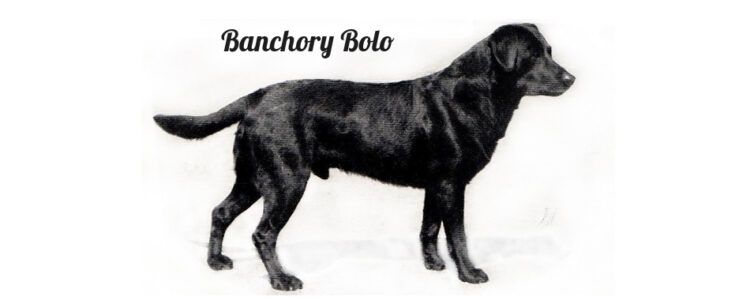
Banchory Bolo was the first-ever Dual Champion Labrador Retriever.
His is an interesting story. Not just rags to riches, but riches to rags and back to riches. Pull up a chair and learn about the dog who still has an influence on Labradors over one hundred years after his birth.
Bolo’s early years
Bolo was two years old when Mrs. Quintin Dick (later Lorna, Countess Howe) entered his life. She had owned his sire, Scandal of Glynn, who was “a charming and beloved companion and a great game-finder.”
When Scandal died, she wanted to find a dog to replace him. Unfortunately, none of the other dogs she owned could fill the gap his passing caused.
Her husband, Quintin Dick, suggested a son by Scandal. However, during the First World War breeding was restricted and Scandal had only sired one litter. In it, there were 13 puppies of which 12 were females.
The only male – originally named Caerhowell Bully – had been given away by his breeder. When Lorna(1) found him, he was given to her with the advice that if she didn’t want to keep him to have him put to sleep. They told her the dog was “hopeless” and had “an evil temper.”
When she picked him up at the train station, she realized what she’d been told was true. The dog was unkempt, had sores on his ears and he growled at her through the heavy muzzle he wore. Although he had a wonderful pedigree, she debated: Should she keep him or put him to sleep as she’d been advised?
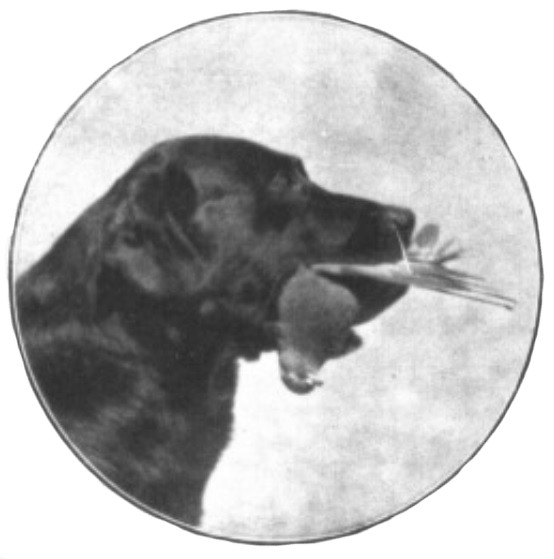
Banchory Bolo
Lorna and Bolo
She must have had a kind heart as she took him home with her. After taking off the muzzle and chain, she turned him loose in a spacious room, but he was distrustful and surly. He wouldn’t come to anyone and it took quite a while to catch him.
Something must have happened to him in his earlier life. Heavy-handed trainer? Malicious kennel help?
He avoided people. When turned out for exercise, he was hard to catch. How could he be trained when he was so distrustful of people? What could soothe the savage beast?
It turns out it wasn’t music, but Lorna’s gentle care. When he became seriously ill, she nursed him back to health. During that time, he realized she was someone he could trust. As he recovered he became devoted to her and was always at her side.
The stirrings of greatness
When he started in training, Lorna found he had “a natural love of retrieving, an excellent nose, and a perfect mouth.” However, he also had two failings: he loved chasing rabbits and was terrified of cracking whips. One day when a stable boy happened to crack a whip near him, the fear took over and Bolo blindly sought escape. A tall, spiked gate didn’t stop him from running.
He returned early the next morning, covered in blood. “He had two very deep wounds on his chest, a tear three inches long in his groin and his hind leg and hock torn so badly that the bone was visible.” Because a veterinarian was too far away, Lorna stitched his wounds as he lay still for her.
Her doctoring and subsequent training was well done as the next fall he won a field trial prize. Then he quickly won two field trials and became a field champion. Two years later he also finished his show championship and became the first Dual Champion Labrador.
Lorna said, “He had quite the best nose I have ever seen in a dog and with apparently the greatest ease he would collect runner after runner after several other dogs had failed. I have never had a dog with such great natural ability or one so anxious to please me in every possible way.”
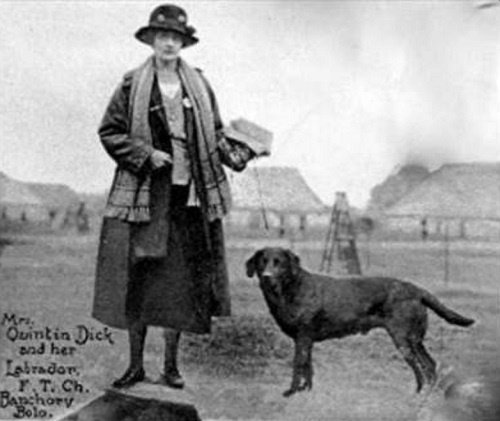
Lorna, Countess Howe and Banchory Bolo
From greatness comes greatness
The genes from several great dogs came together in Banchory Bolo. We have Lord Malmesbury, the Dukes of Buccleuch, and Lord Knutsford (Munden kennels) to thank for their breeding insight and the dogs they produced.
Banchory Bolo’s pedigree:
| Scandal of Glynn | English FTCh Peter of Faskally | Waterdale Gamester |
| Birkhill Juliet | ||
| English FTW Shelagh of Glynn | English FTW Scamp of Glynn | |
| Shelagh of Danesbury | ||
| Caerhowell Nettle | Foxley Kennett | Hirsch’s Ranger |
| Bendysh Bess | ||
| Baker’s Nora | unknown | |
| unknown |
His family
Looking backward in time, Bolo’s sire, Scandal of Glynn, was a son of English FTCh Peter of Faskally. Peter won the International Gundog League’s Championship Stake for retrievers in 1911, but it was his partnership with his handler, Archie Butter, that set him apart from the other retrievers.
Butter realized that if a dog could be guided by his handler, the quicker he would be able to find and retrieve game. To do this, he adapted the methods used by shepherds when handling their dogs using whistles and hand signals. We still use a form of this method today.
Peter of Faskally’s pedigree is filled with dogs from the Munden and Buccleuch kennels. Munden Sixty (born 1897) appears three times in Peter’s pedigree and once more in Scandal of Glynn’s maternal line.
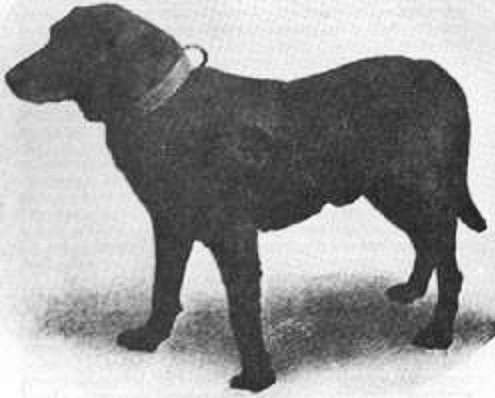
Buccleuch Avon
Sixty’s paternal grandfather, Buccleuch Avon (born 1885), was a gift from the third Earl of Malmesbury to the sixth Duke of Buccleuch.
Avon was sired by Malmesbury Tramp (born 1878) and out of Malmesbury Juno (born 1878). Another male, Buccleuch Ned (born 1882), was also a gift. These dogs were bred to bitches that descended from dogs imported originally by the fifth Duke of Buccleuch.
Another great in Peter of Faskally’s pedigree is Munden Single (born 1899). She was sired by Munden Sixty and descended from Munden, Buccleuch, and Malmesbury dogs. She’s best known for being the first Labrador to win a Challenge Certificate and the first Labrador to run in a field trial.
More Munden, Buccleuch, and Malmesbury
Less is known about Scandal of Glynn’s maternal side. His maternal grandfather, Scamp of Glynn FTW, traces to Buccleuch Ned, the other male gifted by Lord Malmesbury. And his maternal grandmother, Shelagh of Danesbury, is mostly from Munden dogs that trace back to the Buccleuch and Malmesbury kennels.
Even less is known about Banchory Bolo’s mother, Caerhowell Nettle, although her father traces back to Peter of Faskally as well.
Bolo’s legacy
With all the good genes passed down from his ancestors, it’s not surprising that he also produced well. He sired both show champions and field trial champions.
Bolo’s show offspring
In 1921, he was bred to Brocklehirst Nell (owned by Mrs. Dinwoodie) and sired English Ch Banchory Bluff, English FTCh Nith of Halleaths, and Brocklehirst Daisy FTW. Bluff was the maternal grandsire of English FTCh Balmuto Hewildo. Bluff was owned by Lorna.
Also in 1921, he was bred to Murrayfield Bett (owned by Mr. Dinwoodie) and sired English Ch Brocklehirst Donner. This dog was also owned by Lorna.
Yet another litter in 1921, produced English Ch Beningbrough Tangle. He finished his show championship, including winning the CC at Crufts in 1930 and he also won a field trial. So close to being another Dual Champion! He was bred by The Earl of Chesterfield and owned by Lorna. His mother was Thyme, a daughter of English Ch Ilderton Ben.
In 1922, Bolo was bred to a granddaughter of English Ch Ilderton Ben. Her name was Malta of Lunn and was owned by the Earl of Clarendon. In this litter was a female named English Ch Banchory Kelpie, owned by Lorna.
Breeding dogs all but stopped during World War I. This sent the Munden kennel to the edge of extinction. However Lorna “gave Lord Knutsford a puppy on the condition that he should eventually breed her with Dual Champion Banchory Bolo.”
He registered this puppy as Munden Scarcity. Her sire was English Ch Banchory Lucky and her dam was Banchory Betty. In Scarcity’s litter by Bolo, she produced both English Ch Banchory Danilo FTW and English Ch Munden Solo FTW. Lord Knutsford also kept Singer, a bitch, and another bitch was given to His Majesty the King.
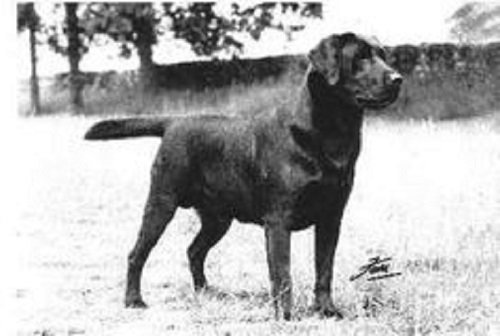
Banchory Danilo
One of Bolo’s best sons
Danilo won 33 Challenge Certificates in the show ring and won the best exhibit in the Kennel Club Show in 1925. He went on to also win two field trial honors in 1924, handled by Lorna. Danilo sired English Ch Drinkstone Pons of Wingan (sire of American Ch Echo of Arden), English Ch Drinkstone Dan, and Haylers Danilo (sire of English Ch Poppleton Black Lancer).
When Danilo’s grandson, Hiwood Risk, was bred to Peggy of Shipton we see some of the Arden dogs, including American National Field Champion Tar of Arden and her offspring – American FC Firelei of Deer Creek, American NFC Black Magic of Audlon, American Dual Ch CFC Little Pierre of Deer Creek.
Danilo’s brother, Munden Solo, also did well at shows. At Crufts in 1927, he competed in ten classes, won six, and placed in three more. The judge wrote of him, ‘If there had been a little more of him in size, I think he would have been very near perfection.’
Bolo sired another English show champion, Banchory Bolo’s Trust, in 1926. His mother was Beaulieu Nance (daughter of English DUAL Ch Banchory Sunspeck).
English DUAL Ch Bramshaw Bob, double-bred on Bolo, won Best in Show at Crufts twice – 1932 and 1933. Lorna bought him from Sir George Thursby and when she took him to Crufts in 1932, Bob won all the classes he was entered in and won Best in Show on the second day.
Lorna said, “Cruft’s Show was, and still is, a great meeting place for gamekeepers. I shall never forget the overwhelming reception they gave Bob when the award was announced; it was so kind of them. They were pleased that a working gundog should receive this much-coveted award.”
Bolo’s field offspring
Bolo was bred to Kirkmahoe Dinah FTW in 1921. This litter included English National FTCh Kirkmahoe Rover, Banchory Corbie FTW, and Choice Of Kirkmahoe FTW.
Banchory Corbie won one Challenge Certificate (show points) and won the 1923 International Gundog League (IGL) Nomination Stake. Then he “broke his shoulder by galloping into a guard post” thus ending his show and field trial career. Lorna described him, “Corbie was in character and temperament all that a Labrador should be. He was highly intelligent, very faithful, a wonderful watch-dog and guard, yet very gentle with children. He had the great game-finding ability which goes with good nose and the brains to use it.”
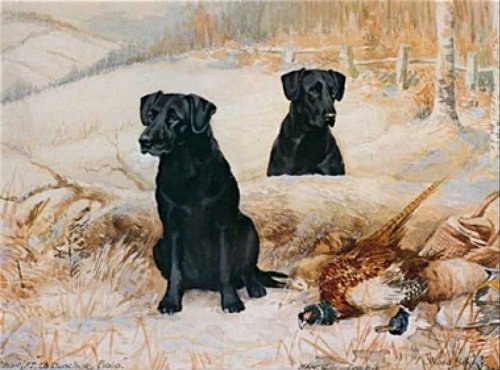
Banchory Bolo and his son, Banchory Corbie
Another Bolo son was born in 1923, Banchory Roger FTW. He was linebred on English National Ch Peter of Faskally and on Munden Sentry.
Another male, English FTCh Balmuto Hewildo, was also double-bred on Bolo. Instead of winning in the show ring, he won the IGL Retriever Championship in 1936. This is comparable to the National Retriever Championship in the US.
In short, Bolo was a great producer.
A legend
Author C. Mackay Sanderson wrote, “Bolo’s coming may be said to have breathed a spirit of new life into the breed, the prestige enjoyed by this dog as a competitive and stud force giving lasting impetus to Labrador fortunes and subsequently his name runs like a golden thread through all the vital streams of progress.”
“The Field wrote of Bolo: ‘If ever evidence were needed of the character of a great dog, and of his influence on the generations following him, it was to be found at the Retriever Championship Trial held at Idsworth last week [December 1932]. Out of fourteen dogs that won prizes, eight were descended from Banchory Bolo.'”
But Bolo also had another legacy – he tended to throw white hairs on the feet. These ‘Bolo marks’ or ‘Bolo pads’ are still sometimes seen on the bottom of the front feet and/or the back of the front pasterns.
Bolo died in July 1927. It was ten years before Lorna was able to give her heart to another dog.
English Dual Champion Banchory Bolo
Whelped: December 29, 1915
Died: July 10, 1927
Owner: Lorna, Countess Howe (AKA Mrs. Quintin Dick)
Breeder: Sir John S Harmood-Banner
Original name: Caerhowell Bully
Registration: KC SB 218AA
1. Although she became Lorna, Countess Howe because of her second marriage, she was known as Mrs Quintin Dick during Bolo’s lifetime. However for the sake of ease, I’ve used her first name here as it’s how she’s known by Lab enthusiasts worldwide.
Abbreviations:
Ch – Show champion
CC – Challenge Certificate (show points)
FCh – Field trial champion
NFCh – National field trial champion
FTW – Field trial winner (not a title)
CFC – Canadian field champion
IGL – International Gundog League
Centronuclear Myopathy (CNM) is an inherited congenital disorder that causes muscle dysfunction.
About CNM
In a nutshell, CNM in Labradors causes muscle wasting which makes moving normally difficult. Some dogs have severe symptoms while other dogs are only mildly affected.
In the past, it’s been called generalized muscle weakness, polyneuropathy, muscular myopathy, muscular dystrophy, hereditary myopathy.
Breeds affected are Labrador Retrievers, plus doodles and other Lab mixes.
Here is a video of a Labrador suffering from acute CNM.
To develop a genetic test, researchers collected samples from 7,426 Labradors living in 18 countries. They found 80 dogs from various countries had two copies of the mutated gene. These dogs all showed muscle wasting symptoms. Of the 1,172 dogs that had one copy of the mutated gene, none showed symptoms which showed that CNM in Labradors is caused by a simple recessive gene.
Dogs with two normal genes are normal. Dogs with one normal gene appear normal, but could pass the mutated gene to their puppies. Dogs with two mutated gene are affected and will develop muscle wasting.
Currently researchers believe the mutated gene is the result of a single mutation. Also that the gene spread rapidly through the Labrador population because many people bred to a small group of popular sires about 60 years ago.
CNM also affects people. Locating the mutated gene in Labradors is helping scientists study the disorder in people.
Symptoms
Symptoms generally develop between two to five months of age and include gait abnormalities, generalized weakness, tiring easily and muscle wasting. CNM can affect both sexes and all three recognized colors.
Puppies seem normal at first, but as they grow they develop generalized muscle weakness and abnormal postures. Another sign is an odd “bunny hop” with the rear legs. Often they can’t exercise much and may collapse in colder weather.
Here is a video of another Lab having a particularly tough day although she’s determined to get her bumper.
Affected dogs will never develop normal muscles. You can see the difference most clearly in the chest and rear legs.
There is no cure. However some dogs, with their owner’s help, have learned how to overcome most symptoms. This dog is doing quite well.
According to his owners, “As a puppy, he couldn’t hold his head up, control his tongue, hold a tug toy, walk for more than a few feet without having to crawl, or climb stairs.”
Preventing CNM in Labradors
CNM is caused by a recessive gene which means a dog can have one copy of the gene and appear normal. If that dog is bred to another dog that appears normal, but has the same recessive gene, some of the puppies may be affected with CNM.
CNM affected dogs should not be bred as all of their puppies will carry the gene. Because of the muscle dysfunction, it may be difficult for a male to breed naturally and even harder for a female to carry and whelp puppies.
Genetic testing is the best way to prevent producing a dog with CNM. Many laboratories offer the testing, but my favorite is DDC. They are available to answer questions, can help order the correct tests and are reasonably priced. They can also provide the swabs needed to collect DNA.
To collect your dog’s DNA, make sure he hasn’t eaten or had anything to drink for at least an hour. You may need to put a leash on your dog and/or have a helper handy to keep him still. The collection doesn’t hurt, but some dogs may object anyway.
Wash your hands and pull out one swab at a time. Lift your dog’s lip on the side of his muzzle and insert the swab between his lip and gums. Swirl several times and remove. Place the swab back in the plastic wrap. Repeat on the other side of his muzzle and then a third time on one side or the other.
Write your name, your dog’s name, breed and registration number on an envelope and place the swabs inside. Seal and place the envelope inside another envelope, seal, address and mail.
If you are collecting samples from more than one dog, be sure to keep their swabs separate and wash your hands between collections.
And, no, CNM is not the same as Exercise Induced Collapse (EIC), although both disorders are genetic. CNM is a muscle weakness whereas EIC is a neurologic dysfunction.
(Originally posted October 25, 2012 – Updated November 18, 2022)
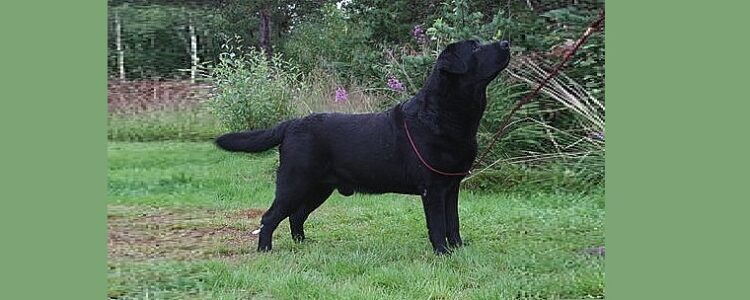
Dickendall Peacekeeper was nicknamed “Chuck” after Chuck Norris, the actor and martial arts expert. Like Chuck (the person), Chuck (the Lab) was sweet and mild-mannered until it was time to go to work – then watch out!
He finished his Junior Hunter title with style and was working on his Senior Hunter title when his handler had a health issue and wasn’t able to finish his title.
Instead, Chuck went globe trotting and spent over a year in Finland where he was popular with the ladies. He is now retired.
Chuck was bred and owned by Dickendall Labs.
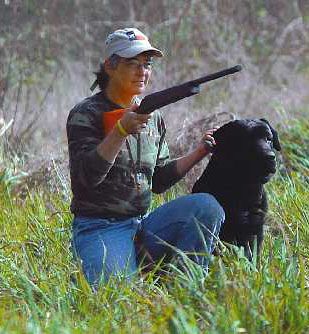
Below is a photo of Chuck’s father, Morgan. He was imported from Europe where he often won in dog shows.
According to Morgan’s owner, “He has 3 CC’s and 2 CACIB’s from Holland, 2 CC’s and 1 CACIB from Finland, 1 CC and 1 CACIB from Sweden and 1 CC from Italy, and several BOBs. He gained the NLV CW’99 title, when winning the dutch Bennekom Club Show out of 800 labradors. He is also Nordic Winner ’99.”
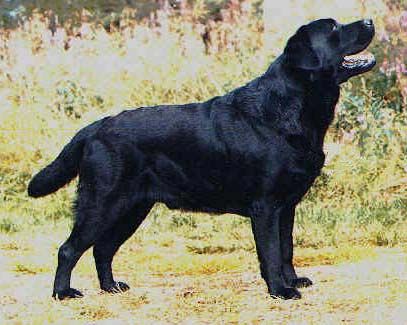
Chuck’s clearances and pedigree:
Hips OFA LR-145035 Good
Elbows LR-EL23955
Eyes CERF: LR-40971
| Dutch CH Trendmakers Tycoon “Morgan” |
Swedish Danish Nordic CH Trendmakers Mugwump | Beechcroft’s Royal Standard |
| Guideline’s Manuscript | ||
| Trendmakers Traffic Jam | Smart Fellow’s Order From New York | |
| Blondella Balanced Shades | ||
| Dickendall Davaron Peaceful | CH Dickendall Arnold | CH Dickendall Ruffy SH |
| Dickendall’s A-Ha | ||
| Pucketts Ping Pong | Follytower Man O’War | |
| Dickendall H Of Criner Hills |
His legacy
We had one of Chuck’s very talented daughters, SHR Justamere Jazz Singer CD JH RE CGC WC CC, or Jazzy for short. Jazzy loved retrieving and snuggling on the couch. She gave us another generation of talented Labradors.
Jazzy’s brother, Jack, was also a very accomplished Labrador. His full name with titles is SHR Justamere Jack O’ The Green RAE JH CC.
Two of Chuck’s sons finished their championships – CH Buckstone Surviv’n On Ayr “Martin” and Ukn CH Mallorn’s Madmax.
Other dogs sired by Chuck include:
Banbury’s Sweetest Taboo
Brooks Major Decision
Brooks Here To Start The Party At Countryhaven
Hightide Snowworry Just Chilln
Whispering Pine’s Bewitched
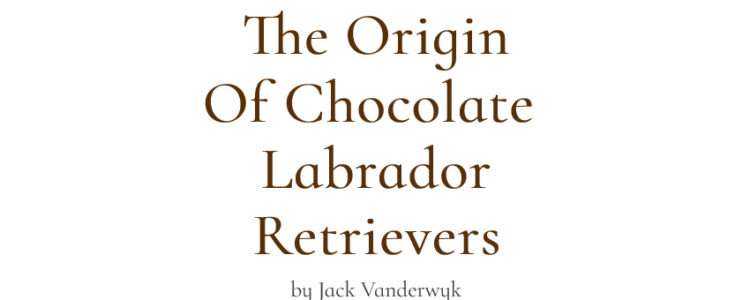
Studying the pedigrees of chocolate Labrador Retrievers, you often wonder where the chocs are coming from. All of a sudden they are there, out of the blue. I studied the files in the LabradorNet database, which contains the pedigrees of more than 90,000 Labradors, and came to the conclusion that there are roughly 8 routes to the origin of chocolate Labs.
One of the reasons that you’ll find no chocolate Labs in the older files, is that they weren’t in fashion for many decades, so they just weren’t registered. However, the blacks and the yellows carrying the choc gene kept reproducing, and that’s why we’re able to trace them all the way back to the late 1800s.
Note: This article was written by Jack Vanderwyk. After his death his domain name was usurped by someone else. Fortunately I had a copy of his work and it’s shared here in a tribute to the research he did on Labrador Retriever pedigrees.
ORIGINS OF THE CHOCOLATE GENE
According to the studbook of Buccleuch Kennels, the chocolates in that kennel came through FTW Peter of Faskally (1908). However, Peter of Faskally was a descendant of Buccleuch Avon (1885).
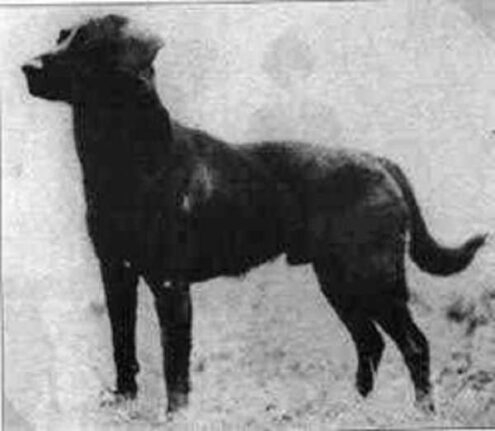
Peter of Faskally

Buccleuch Avon
The Earl of Feversham had some typical specimen of chocolates, his Nawton Pruna (who produced yellow offspring) did well at field trials in the years preceding the First World War.
One of the chief supporters of chocolates was the Hon. Lady Ward of Chiltonfoliat, near Hungerford, the dogs from her kennel being very typical with particularly good tails and coats. Her chocolate bitch FTW Darry of Chiltonfoliat (Braeroy Darkie) (1930) was sired by an unregistered chocolate dog called Jimmy, while her dam descended from the chocolate Flatcoat Clyde (see further down).
Mr. J.G. Severn of Tibshelf Kennels wrote: “My first experience of the chocolate Labradors was in February, 1938, when I visited Dr. Montgomery of Sutton Ashfield, about three miles from Tibshelf. We had mated his black bitch Shelagh of Brasidonia to my black dog Danilo of Tibshelf. Result: 4 blacks, 2 chocolate dogs, 1 cream bitch. I later bought Shelagh and mated her again to Danilo. Result just the same.”
Miss Wills of Metesford Kennels produced several chocolates in the late 1940s, early 1950s, but their descendance is not known.
CROSSES IN THE EARLY BREED
Further more we should keep in mind that there are a lot of missing links in our database, and sometimes the reasons for this are rather obvious. I found 21 interbred or fullbred Flatcoats or Chesapeake Bay retrievers in our Labrador retriever database, all born in the U.K. between 1914 and 1933.
Of all the 21 interbred or fullbred Flatcoats or Chesapeake Bay retrievers, most of them being Field Trial champions, we could only track the ancestors for more than two generations of two dogs. The information about the ancestors of the other 19 interbred dogs was simply removed from the files in the 1930s. It seems that some well known Labrador breeders didn’t want the public to know that their successful dogs were partly the offspring of interbred dogs.
Two well known Chesapeake Bay retrievers were a dog called Jolly, who sired the male Labrador retriever Jolly Sam, born before 1933, and the bitch Corydalys, who was the dam of the female Labrador retriever Micklefield Juno, born before 1925.
Clyde, born before 1923, was the “liver” (chocolate) Flatcoat retriever who sired the male yellow Labrador FTW Folkingham Bexter (1925), who in turn sired the yellow bitch FTW Limekiln Rhoda (1927). She and the yellow dog FTW Golden Morn (1926) had a litter that was registered as “half Golden Retriever and half Labradors”. The separation was by coat length, because all puppies were yellow. Apparently the third generation showed some traits of the original breed involved.
The chocolate Labrador may not have been very popular prior to the 1960s, but they were mentioned as early as 1927, in The Book of Dogs, published by the National Geographic Society in 1927: “This Labrador dog, crossed probably with the English setter, and perhaps with other breeds, produced the Retriever, which may be either black or liver-brown.” (The yellow Labrador was organized in The Yellow Labrador Retriever Club, in 1924.)
ROUTES TO THE EARLY CHOCOLATE GENE
Route 1 (version 1):
– Morningtown Tobla (f, choc, < 1976)
- Brentville Ebony (f, black, <1974)
- Knavery Mistress Meg (f, black < 1972)
- Sandylands Mark (m, black, 1965)
– Reanacre Mallardhurn Thunder (m, black, 1960)
– Mallardhurn Pat (f, yellow, < 1958)
- Poppleton Lieutenant (m, yellow, 1949)
- Poppleton Golden Sunray (f, yellow, < 1947)
- Poppleton Golden Major (m, yellow, < 1940)
- Poppleton Black Lancer (m, black, 1934)
- Haylers Danilo (m, black < 1932)
- Banchory Danilo (m, black, 1923)
- Banchory Bolo (m, black, 1915)
– Scandal of Glynn (m, black, < 1913)
- Shelag of Glynn (f, black, < 1911)
- Shelag (f, colour unknown, < 1909)
- Munden Sentry (m, black, 1900)
- Munden Sixty (m, black, 1897)
- Buccleuch Nith (m, black, 1891)
- Buccleuch Avon (m, black, 1885)
- Malmesbury Tramp (m, black, 1878).[/st_text][/st_column][st_column span="span6"][st_image image_file="https://justamere.com/wp-content/uploads/2023/04/Sandylands-Mark.jpg" image_size_wrapper="" image_size="full" image_alt="Sandylands Mark, a famous show champion Labrador Retriever and stud dog" image_alignment="center" id_wrapper="image_fdd536cac8f3d3e21e9f3c9a780623b9" ][/st_image][st_text el_title="Sandylands Mark" text_margin_top="10" id_wrapper="text_ee2bb854c3a5e4ec7be402f33a30736e" ]
Sandylands Mark
Route 1 (version 2):
– Morningtown Tobla (f, choc, < 1976)
- Brentville Ebony (f, black, <1974)
- Knavery Mistress Meg (f, black < 1972)
- Sandylands Mark (m, black, 1965)
- Reanacre Mallardhurn Thunder (m, black, 1960)
– Mallardhurn Pat (f, yellow, < 1958)
- Poppleton Lieutenant (m, yellow, 1949)
- Poppleton Golden Sunray (f, yellow, < 1947)
- Poppleton Golden Major (m, yellow, < 1940)
- Poppleton Black Lancer (m, black, 1934)
- Haylers Danilo (m, black < 1932)
- Boris de Main (f, yellow, < 1930), child of:
Sceptre (m, colour unknown, not registered, < 1928) and
Countess (f, colour unknown, not registered, < 1928).
However, Buccleuch Avon, born in 1885, so almost 40 years before, is known to have produced some chocolate offspring, so it's more likely that either his sire Malmesbury Tramp, or his dam Malmesbury June (f, black, 1880), or both, already carried the chocolate gene.[/st_text][/st_column][st_column span="span6"][st_image image_file="https://justamere.com/wp-content/uploads/2022/03/Reanacre-Mallardhurn-Thunder-1960-e1682638638659.jpg" image_size_wrapper="" image_size="full" image_alt="Reanacre Mallardhurn Thunder, an English show champion Labrador Retriever from the 1960s" image_alignment="center" id_wrapper="image_c289d382003fbdbc6f4a52a23d679d7c" ][/st_image][st_text el_title="Reanacre Mallardhurn Thunder" text_margin_top="10" id_wrapper="text_d1c8ad849fe459926c5cf15ae198bb35" ]
Reanacre Mallardhurn Thunder
Route 2:
– Follytower Merrybrook Black Stormer (m, black, 1969)
– Sandylands Tandy (m, yellow, 1961)
– Sandylands Shadow (f, black, 1959)
– Diant Pride (f, yellow, < 1957)
- Poppleton Lieutenant (m, yellow, 1949)
- Poppleton Golden Sunray (f, yellow, < 1947)
- Poppleton Golden Major (m, yellow, < 1940)
- Poppleton Black Lancer (m, black, 1934)
- Haylers Danilo (m, black < 1932)
- Banchory Danilo (m, black, 1923)
- Banchory Bolo (m, black, 1915)
- Scandal of Glynn (m, black, < 1913)
- Shelag of Glynn (f, black, < 1911)
- Shelag (f, colour unknown, < 1909)
- Munden Sentry (m, black, 1900)
- Munden Sixty (m, black, 1897)
- Buccleuch Nith (m, black, 1891)
- Buccleuch Avon (m, black, 1885)
- Malmesbury Tramp (m, black, 1878).[/st_text][/st_column][st_column span="span6"][st_image image_file="https://justamere.com/wp-content/uploads/2022/03/Follytower-Merrybrook-Black-Stormer-1969-e1682639040835.jpg" image_size_wrapper="" image_size="full" image_alt="Follytower Merrybrook Black Stormer, a show Labrador and prepotent stud dog" image_alignment="center" id_wrapper="image_561b6197c9676a065fb8d4803dfb49ab" ][/st_image][st_text el_title="Follytower Merrybrook Black Stormer" text_margin_top="10" id_wrapper="text_2034d43c2c3092e178d84394236fd34a" ]
Follytower Merrybrook Black Stormer
Route 3:
– Fabracken Comedy Star (m, black, 1979)
– Martin of Mardas (m, black, 1975)
– Ballyduff Marketeer (m, black, 1974)
– Sandylands Mark (m, black, 1965)
– Reanacre Mallardhurn Thunder (m, black, 1960)
– Mallardhurn Pat (f, yellow, < 1958)
- Poppleton Lieutenant (m, yellow, 1949)
- Poppleton Golden Sunray (f, yellow, < 1947)
- Poppleton Golden Major (m, yellow, < 1940)
- Poppleton Black Lancer (m, black, 1934)
- Haylers Danilo (m, black < 1932)
- Banchory Danilo (m, black, 1923)
- Banchory Bolo (m, black, 1915)
- Scandal of Glynn (m, black, < 1913)
- Shelag of Glynn (f, black, < 1911)
- Shelag (f, colour unknown, < 1909)
- Munden Sentry (m, black, 1900)
- Munden Sixty (m, black, 1897)
- Buccleuch Nith (m, black, 1891)
- Buccleuch Avon (m, black, 1885)
- Malmesbury Tramp (m, black, 1878).[/st_text][/st_column][st_column span="span6"][st_image image_file="https://justamere.com/wp-content/uploads/2022/03/Fabracken-Comedy-Star-e1682639413905.jpg" image_size_wrapper="" image_size="full" image_alt="Handsome black Lab named Fabracken Comedy Star, standing near a river" image_alignment="center" id_wrapper="image_38c75d728a04949b17ced37f170e64e5" ][/st_image][st_text el_title="Fabracken Comedy Star" text_margin_top="10" id_wrapper="text_84291af2c46e69adce952479c459fe52" ]
Fabracken Comedy Star
Route 4:
– Olivia of Blaircourt (f, black, < 1954) - Lawrie of Blaircourt (m, black, < 1952) - Fiona of Blaircourt (f, black, < 1950) - Treesholme Thunder (m, black, < 1948) - Triumph of Treesholme (m, yellow, < 1946) - Poppleton Golden Sherry (f, yellow, < 1944) - Poppleton Golden Gleam (f, yellow, < 1942) - Poppleton Golden Major (m, yellow, < 1940) - Poppleton Black Lancer (m, black, 1934) - Haylers Danilo (m, black < 1932) - Banchory Danilo (m, black, 1923) - Banchory Bolo (m, black, 1915) - Scandal of Glynn (m, black, < 1913) - Shelag of Glynn (f, black, < 1911) - Shelag (f, colour unknown, < 1909) - Munden Sentry (m, black, 1900) - Munden Sixty (m, black, 1897) - Buccleuch Nith (m, black, 1891) - Buccleuch Avon (m, black, 1885) - Malmesbury Tramp (m, black, 1878).[/st_text][/st_column][st_column span="span6"][st_image el_title="Martin of Mardas" image_file="https://justamere.com/wp-content/uploads/2022/03/Martin-of-Mardas.jpg" image_size_wrapper="" image_size="full" image_alt="Martin of Mardas, a black Labrador Retriever show dog" image_alignment="center" id_wrapper="image_e734f3b0a0096ca2dfc744a3f6f7239d" ][/st_image][st_text el_title="Martin of Mardas" text_margin_top="10" id_wrapper="text_8e5de3eab75d9ef9a6612bcb60cd3b36" ]
Martin of Mardas
Route 5:
– Pride of Craigavon (m, chocolate, < 1974)
- Taffy of Keithray (m, black, 1965)
- Sandylands Tweed of Blaircourt (m, black, 1958)
– Ruler of Blaircourt (m, black, 1956)
– Olivia of Blaircourt (f, black, < 1954)
- Lawrie of Blaircourt (m, black, < 1952)
- Fiona of Blaircourt (f, black, < 1950)
- Treesholme Thunder (m, black, < 1948)
- Triumph of Treesholme (m, yellow, < 1946)
- Poppleton Golden Sherry (f, yellow, < 1944)
- Poppleton Golden Gleam (f, yellow, < 1942)
- Poppleton Golden Major (m, yellow, < 1940)
- Poppleton Black Lancer (m, black, 1934)
- Haylers Danilo (m, black < 1932)
- Banchory Danilo (m, black, 1923)
- Banchory Bolo (m, black, 1915)
- Scandal of Glynn (m, black, < 1913)
- Shelag of Glynn (f, black, < 1911)
- Shelag (f, colour unknown, < 1909)
- Munden Sentry (m, black, 1900)
- Munden Sixty (m, black, 1897)
- Buccleuch Nith (m, black, 1891)
- Buccleuch Avon (m, black, 1885)
- Malmesbury Tramp (m, black, 1878).[/st_text][/st_column][st_column span="span6"][st_image el_title="Sandylands Tweed of Blaircourt" image_file="https://justamere.com/wp-content/uploads/2022/03/Sandylands-Tweed-of-Blaircourt_1958-e1682640236289.jpg" image_size_wrapper="" image_size="full" image_alt="Sandylands Tweed of Blaircourt, a famous show and stud dog" image_alignment="center" id_wrapper="image_27143f1855b06221b27c5477b20d4dfa" ][/st_image][st_text el_title="Sandylands Tweed of Blaircourt" text_margin_top="10" id_wrapper="text_7acb8cc03d8e84e302c769847201f742" ]
Sandylands Tweed of Blaircourt
Route 6:
– Cookridge Oscar (m, chocolate, < 1960)
- Bickerton Salmon Prince (m, yellow, < 1958)
- Blondie of Gloamin (f, yellow, < 1956)
- Raider of Gloamin (m, colour unknown, < 1954)
- Marquis of Gloamin (m, yellow, < 1944)
- Poppleton Golden Major (m, yellow, < 1940)
- Poppleton Black Lancer (m, black, 1934)
- Haylers Danilo (m, black < 1932)
- Banchory Danilo (m, black, 1923)
- Banchory Bolo (m, black, 1915)
- Scandal of Glynn (m, black, < 1913)
- Shelag of Glynn (f, black, < 1911)
- Shelag (f, colour unknown, < 1909)
- Munden Sentry (m, black, 1900)
– Munden Sixty (m, black, 1897)
– Buccleuch Nith (m, black, 1891)
– Buccleuch Avon (m, black, 1885)
– Malmesbury Tramp (m, black, 1878).

Munden Sentry
Route 7:
– Chocolate Lady (f, chocolate, < 1954) - Harehope Bliss (m, black, 1936) - Weston Bunty (f, black, < 1934) - Adderley Tyke (m, black, 1929) - Adderley Trim (f, black, 1927) - Beningbrough Tanco (m, black, 1924) - Banchory Corbie (m, black, 1921) - Banchory Bolo (m, black, 1915) - Scandal of Glynn (m, black, < 1913) - Shelag of Glynn (f, black, < 1911) - Shelag (f, colour unknown, < 1909) - Munden Sentry (m, black, 1900) - Munden Sixty (m, black, 1897) - Buccleuch Nith (m, black, 1891) - Buccleuch Avon (m, black, 1885) - Malmesbury Tramp (m, black, 1878).[/st_text][/st_column][st_column span="span6"][/st_column][/st_row][st_row ][st_column span="span6"][st_text el_title="route 8" id_wrapper="text_4b035793d80c131265930cb8ade3a015" ]
Route 8:
– Hiwood Mike (m, black, 1935), via Pettistree Dan (m, black, 1934)
– Quest of Wilbury (f, black, 1930)
– Muntham Raven (f, black, 1924)
– Banchory Corbie (m, black, 1921)
– Banchory Bolo (m, black, 1915)
– Scandal of Glynn (m, black, < 1913)
- Shelag of Glynn (f, black, < 1911)
- Shelag (f, colour unknown, < 1909)
- Munden Sentry (m, black, 1900)
- Munden Sixty (m, black, 1897)
- Buccleuch Nith (m, black, 1891)
- Buccleuch Avon (m, black, 1885)
- Malmesbury Tramp (m, black, 1878),
AND
via Pettistree Poppet (f, colour unknown, < 1933)
- Cransford Flapper (f, colour unknown, < 1931)
- Peter of Bircham (m, colour unknown, < 1930)
- Banchory Danilo (m, black, 1923)
- Banchory Bolo (m, black, 1915)
- Scandal of Glynn (m, black, < 1913)
- Shelag of Glynn (f, black, < 1911)
- Shelag (f, colour unknown, < 1909)
- Munden Sentry (m, black, 1900)
- Munden Sixty (m, black, 1897)
- Buccleuch Nith (m, black, 1891)
- Buccleuch Avon (m, black, 1885)
- Malmesbury Tramp (m, black, 1878).[/st_text][/st_column][st_column span="span6"][/st_column][/st_row][st_row id_wrapper="elm_644b0daa73335" ][st_column span="span12"][st_text el_title="more research" id_wrapper="text_be01bbdf89f946df3eba025f8762c099" ]
MORE RESEARCH
I researched some 30 well known chocolate Labrador Retrievers without any known chocolate ancestors, and their pedigrees all fit in with one (or several) of the routes above. Please keep in mind that famous Labradors like Boothgates Headliner, Lindall Mollie Malone, Morningtown Stormette etc all descend from Morningtown Tobla (route 1).
Aroscas Chocolate Surprise: route 1, via Sandylands Mark.
Bradking Cassandra: route 2, directly and via Ardmargha Mad Hatter and Sandylands Mark.
Brendale Brown Betty: route 2 and 5.
Brentwoods Sweet Molly Brown: route 2, via Mardas Brandlesholme Sam’s Song.
Captain Kirk of Rangeways: route 1 and 2.
Castlemore Bramble: route 1 via Sandylands Mark, route 5 via Pride of Craigavon.
Charway Mattie Brown: route 3.
Charway Sally Brown: route 2.
Chocolate Lady: route 7, via Harehope Bliss.
Cookridge Oscar: route 6, via Bickerton Salmon Price.
Cookridge Tango: route 5, via Sandylands Tweed of Blaircourt.
Could Be’s Chestnut Wrangler: route 4, via Could Be’s Rusty Rock, Could Be’s Haven Rock, Indian Valley Rob Roy, Bart of Blaircourt and Rush of Blaircourt.
Follytower Brownthorn: route 2, via Charway Blackthorn of Follytower.
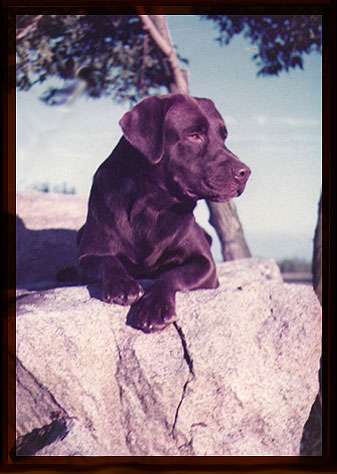
Castlemore Bramble
Gunfield’s Super Charger: route 8, via Shamrock Acres Super Drive, Super Chief, Paha Sapa Chief II, Freehaven Muscles, Grangemead Sharon.
Gunotter’s Chocolate Nip: route 5, via Harris Tweed of Ide and Sandylands Tweed of Blaircourt.
Haverhill’s Brown Belle: route 1, via Dickendall Flip Flop, Sandylands Midas and Reanacre Mallardhurn Thunder.
Ironwood Cocoa Mocha: route 8, via Del Tone Colvin, Cork of Oakwood Lane, Coastal Charger of Deer Creek, Little Pierre of Deer Creek.
Lawnwoods Chocolate Fudge: directly via route 2, and route 1 via Lawnwoods Tapestry and Reanacre Mallardhurn Thunder.
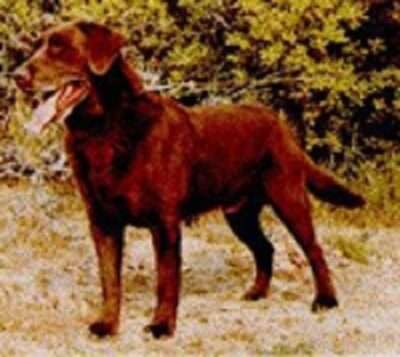
Gunfield’s Super Charger
Lawnwoods Hot Chocolate: route 2.
Lenches Chocolate Liquor: Route 1 via Lasgarn Ludovic and Sandylands Mark.
Loughderg Fiona: route 4, via Ruler of Blaircourt.
Marbra Leprechaun: route 2.
Pride of Craigavon: route 5.
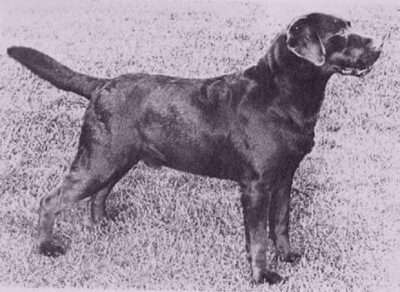
Lawnwoods Hot Chocolate
Pumerang Connection With Stormley: route 2, the easy way via Harrop Black Jack, or take the detour via Stormley Lynx with Pumerang, Ravenshall Charmer at Stormley, Clayford Music At Midnight At Stormley, Lawnwoods Midnight Folly and Lawnwoods Fandango.
Roydwood Rowntree at Ravenshall: route 1 and 2, via Keithray Lucinda, Contessa of Keithray and Sandylands Tandy.
Simandem Sam Browne of Balrion: route 2, via Charway Blackthorn of Follytower.
Sorbus Brown Jay: route 5, via Alvgardens Sam, Alvgardens Jet, Alvgardens Flap, Sandylands Twanah and Sandylands Tweed of Blaircourt.
Tracers Sweet Georgia Brown: route 2, via Follytower Chevalier of Ranfurly and Follytower Augusta.
Waltham Galaxy of Condor: route 1, via Jayncourt Stormer and Sandylands Mark.
Whisky Creek Brown Buina: route 4, via Indian Valley Raed Wulf and Bart of Blaircourt.
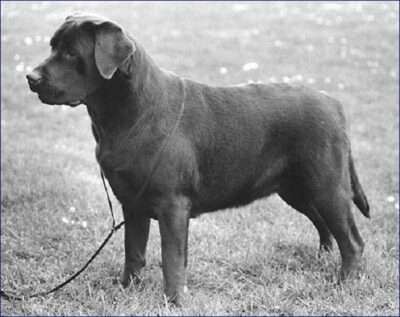
Pumerang Connection With Stormley
Williston Brown Smith: route 1, via Sebastian of Anderscroft, Sandylands Midas and Reanacre Mallardhurn Thunder.

Williston Brown Smith
I’m pretty sure that at least 99% of all chocolate Labradors can be categorized using one of the 8 routes above.
Several routes can be taken to track the origin of chocolate Labs.

Wetherlam Nutcracker, ancestor of most of my chocs.
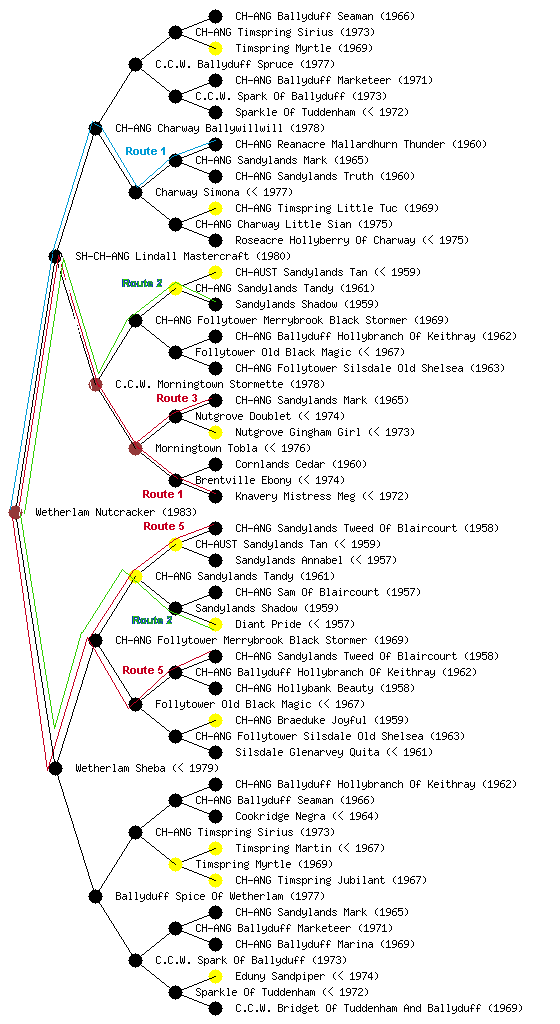
Jack Vanderwyk,
LabradorNet
May 5, 2003

HNPK in Labrador Retrievers is a genetic disorder that results in the formation of crusty skin on the nose. This disorder can lead to discomfort and other complications. Although it’s not life-threatening, it can affect your dog’s quality of life.
This article will explore HNPK, its symptoms, causes, diagnosis, and treatment.
What Is HNPK in Labrador Retrievers?
Hereditary nasal parakeratosis is quite a mouthful. Let’s break it down:
- hereditary = transmitted genetically from parent to offspring
- nasal = of, in, or relating to the nose
- para = prefix denoting a departure from the normal
- keratin = key structural material making up hair, nails, claws, and the outer layer of skin
- …osis = often implies an abnormal or diseased condition
So HNPK is an inherited skin disorder affecting the nose and has been found only (so far) in Labrador Retrievers and Lab crosses such as doodles and dilutes.
To avoid producing it, at least one parent should be tested clear before breeding.
Symptoms
Affected dogs have dry, rough, brown, or grey crusts that develop on the surface and along the edges of the nose. It’s often described as a “dry, crusty nose.”
There may also be some bumps and/or a loss of pigment in the nose. Affected areas are also prone to bacterial infections that can become chronic. Dogs are otherwise healthy.
Although it’s not a fatal condition, affected dogs suffer discomfort and pain if symptoms are not treated. In extreme cases, the dog’s nose will crack which leads to inflammation and continuous irritation.
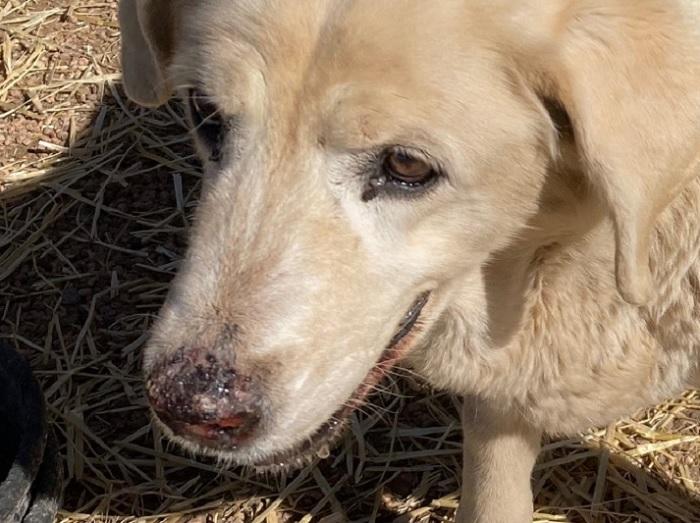
Causes of HNPK
HNPK is a hereditary condition, meaning it is passed down from parents to their puppies. It’s caused by a gene mutation that causes keratinization of the nose.
A puppy with two copies of the mutated gene will likely develop symptoms between six months to one year of age.
Diagnosis of HNPK
Your veterinarian will first perform a thorough physical examination, focusing on the condition of your dog’s nose.
If HNPK is suspected, a genetic test can confirm the diagnosis. Often this is just a swab inside your dog’s cheek to collect a DNA sample.
Cheek swabs
Owners can do the cheek swab themselves. The swabs are like Q-tips, except they are sterile and have a long wooden handle. Your veterinarian may give you some swabs, or you can order some when you order the test. You will need three swabs.
Make sure your dog has not had anything to eat or drink for at least an hour before you collect samples. Slide the swab between your dog’s cheek and gum, then twirl it approximately ten times. Return it to the plastic envelope and repeat with a clean swab. Take a sample from your dog’s other cheek with the third swab.
Put the plastic envelope with the three swabs into a paper envelope and seal it. Write your name plus your dog’s name and breed on the outside of the envelope. Then put that envelope into a larger envelope. I use a 5×7″ manila envelope. Address and mail to the laboratory. I like DDC because they’re relatively fast and inexpensive. I also like that I can call to ask questions and place my order.
Treatment and management of HNPK
Unfortunately, there is no cure for HNPK. Treatment can help your dog feel better and improve his quality of life. This can include:
- Regular application of moisturizing creams or ointments to the nose
- Antibiotics or anti-fungal medications if an infection is present
- Using a plastic cone to prevent rubbing
- Regular check-ups to monitor the condition
Preventing HNPK
It’s a genetic disorder that requires two copies of the mutated gene – one from the father and one from the mother. The only prevention is to avoid breeding two dogs that carry the mutated gene.
A puppy with one copy of the mutated gene will appear normal and won’t develop symptoms.
To be sure puppies won’t develop symptoms at least one parent must be clear of the mutated gene. One or both parents can be tested as detailed above. Another option is if one parent is “clear by parentage.” In this case both the mother and father of one of the parents must be tested clear.
A dog with no symptoms but DNA testing shows he is a carrier of HNPK should only be bred to a clear dog. None of these puppies will develop symptoms, but some may carry the mutated gene.
An affected dog can also be bred, but it should only be to a dog tested clear. In this case, all of the puppies will be carriers but not affected.
In conclusion, although HNPK can’t be cured, it can be managed with proper care and treatment. If you’re a Labrador Retriever owner, it’s important to be aware of this condition and check with your veterinarian if you notice any signs of HNPK in your dog.

Bringing your new puppy home is such an exciting time, but are you ready? Puppies need care and a lot of attention. It’s up to you to provide a safe environment. Check your house and buy your supplies before you bring your puppy home.
Here’s a checklist to help you get started!
Preparation
Schedule an appointment with your veterinarian for a day or so after you’re scheduled to pick up your puppy.
Identify an emergency veterinarian as not all vets are available at night or on weekends.
If needed, find a reputable day care, puppy class and/or trainer.
Determine where the puppy will sleep, preferably in a crate to start.
Determine who will be primarily responsible for feeding and caring for the puppy. As the puppy starts to learn commands, be sure everyone uses the same command to not confuse the puppy.
Getting your house and garage ready
Safety first! Get down at your puppy’s level and search for everything that could be potentially dangerous and for anything you don’t want chewed. Also be aware of anything your puppy could jump or climb on to reach higher.
Check every room in your house plus the yard, garage and any other buildings your puppy might be able to access.
In the house:
Check behind any furniture where your puppy could hide and block it off. Block access to under beds.
Protect electrical cords, TV and computer cables and electrical outlets. It’s very common for puppies to chew on wires, but it can be deadly. Don’t forget about remote controls.
Keep shoes and clothing picked up or behind closed closet doors.
Place all medication and supplements inside a cupboard well out of reach of your puppy’s best efforts. Those bottles might be “child proof”, but they won’t last long against puppy teeth.
Store all cleaning supplies in a cabinet secured with a cable or in a high cabinet that the puppy can’t climb. Don’t forget to put bars of soap, bottles of shampoo, makeup, razors, cotton balls, tissues, aftershave, perfume, etc out of reach.
Secure all trash containers with a puppy-proof lid or inside a cabinet.
Store decorations, candles, plug-in scented sprays out of reach or in a secured cabinet.
Store office supplies such as rubber bands, staples and paperclips in drawers or a secure cupboard.
Keep cigarettes, cigars and loose tobacco out of reach of puppies.
Check for toxic plants inside – and outside – of the house. Move them safely out of the puppy’s reach. Check for plants are poisonous for dogs.
If you have cats or other pets, move the litter box where the puppy can’t get to it.
Don’t forget to check every closet or cubbyhole.
If there is an area that just can’t be puppy proofed, use a quality baby gate and/or an exercise pen to keep him out.
Be vigilant about keeping everything put away, out of puppy’s reach.
Garage and yard:
Check for holes in or under your fencing and anything your puppy could climb in, on or under.
If you have a deck, place a barrier so the puppy can’t fall off or down the stairs.
Move all paint, pesticides, rodent poisons, cleaners, chemicals, bug spray, fertilizers, etc out of puppy’s reach – at least five feet off the floor – or in a secured cabinet.
Store tools and power equipment out of puppy’s reach.
Do the same with antifreeze, fuel and other car fluids. These may taste sweet to a puppy, but they are deadly.
If any trash cans don’t have a secure lid, place the can in a secure cupboard or out of puppy’s reach.
Check for plants that could be potentially toxic to your puppy using the link above. These items are also toxic:
- pit fruits such as apricots, cherries, peaches, plums and avocados
- garlic, onion and chives
- grapes and currants
- chili peppers
- lemons, limes, oranges and grapefruit
- potatoes and tomatoes
- rhubarb
- tobacco
- coffee grounds and tea bags
Move or place a puppy-proof barrier around any toxic plants.
Check everything a second time a day or so before you welcome your puppy home.
Safety products
Now that you’ve found potential trouble spots, here are some products that might help.
Electrical:
For some reason, puppies are attracted to power cords. They’re small enough to fit in their mouths, easy to chew and potentially deadly.
Clear Electrical Wire Protector (Total 30 Feet)
Wire Loom Tubing To Protect Wires from Pets
Outlet Covers 38-Pack White Child Proof Electrical Plug Covers
Electrical Outlet Cover Box Childproof Large Plug Cover (Transparent)
Dual Fit Outlet Plug Cover White 2 Count
Securing cabinets and other areas:
Child Safety Strap Locks (10 Pack) White/Gray
Under Bed Couch Blocker for Pets 8 Pack 4.7″ High 126″ Long
Mom’s Choice Award – Metal Baby Gate, 29-48″ Extra Wide Pressure Mounted
Banister Guard Child Safety Net – 15ft x 3ft tall (white)
Outdoor Deck Rail Safety Net – 16ft x 38″ tall (black)
Puppy supplies
After safety-proofing your house, what do you need for puppy?
Health:
Pet Thermometer Waterproof Fast and Accurate Measurements
Disposable Probe Covers for Thermometer, 50 Count
Pet Infrared Ear Thermometer for Dogs and Cats, Rechargeable ℃/℉
Collars and leashes:
If you must add tags to your puppy’s collar, tape them flat to the collar. Dangling tags can be caught in heat/AC vents, openings in crates and many other narrow openings. When that happens dogs will often fight against it and may twist to the point of strangulation.
Also, if you have more than one dog and they like to play – especially if they grab each other by the neck – remove the collars. Too many dogs have died of strangulation when they caught their lower jaw in another dog’s collar. Both will struggle and twist. And it happens fast. I had it happen. Both dogs wore quick-release collars, but one twist and one dog was choking while the other dog fought to get free. Had I not been 15 feet away when it happened, at least one dog would probably have died. My dogs no longer wear collars except when competing, however they are all microchipped.
Unless you have a short nose dog like a Pug or a dog with a slender head like a Greyhound, avoid using a harness. Harnesses can be hard to fit and a poorly-fitted harness can cause chafing or allow the dog to slip out. It should also be taken off when the dog doesn’t need to be on leash.
Reflective Multi-Colored Stripe Adjustable Dog Collar, Violet and River Blue, Medium, Neck 14.5″-20″
Avoid retractable leashes – “flexi-leads” – especially for puppies. More accidents seem to happen with these leashes. Even a small dog running toward an attraction can hit the end of the cord and snap the clasp or collar. When that happens the cord will quickly retract and possibly hit you or bystanders causing “broken teeth, due to the collar or metal clasp breaking and swinging back into your face.” Grabbing the cord or having it wrap around a hand or leg can lead to deep cuts and even amputation.
This is a better option than a flexi-lead. It adjusts to 3 lengths: 4, 5 and 7-1/2 feet. Clip it around your chest, waist or shoulder to free your hands. It’s available in a variety of colors.
Adjustable Dog Training Leash | Secure & Non-Slip Rubberized Nylon Grip Hands Free Dog Leash (Black)
Bowls:
I have some of these bowls. They’re almost indestructible, dishwasher safe and don’t move around like regular stainless steel bowls.
Deep Stainless Steel Anti-Slip Dog Bowls, Set of 2, Each Holds Up to 6 Cups
Another option if you have a fast eater is this slow feeder bowl. There are several design, color and size choices.
Outward Hound Fun Feeder Slo Bowl, Slow Feeder Dog Bowl, Medium/Mini, Orange
Beds:
Reasonably priced washable dog beds, sized to fit in crates. Medium for puppies and smaller Labs 30x20x3″. Large for an adult Lab 36x24x3″. Extra Large for a big, adult male Lab 48x24x3″.
Waterproof Dog Bed, Reversible, Removable Washable Cover & Waterproof Inner Lining – Medium
Probably best to wait on introducing a quality dog bed until your puppy is house-trained and past the teething stage. Otherwise these are outstanding dog beds.
Best Friends by Sheri The Original Calming Donut Cat and Dog Bed in Shag Fur Taupe, Extra Large 45×45 – big enough for adult dog
Grooming:
This is my go-to brush for Labs. It’s great for removing dirt and dead hair and the dogs love the attention.
Zoom Groom Dog Brush, Groom and Massage While Removing Loose Hair and Dead Skin – Blue
If your dog grows a thicker coat than the Zoom Groom can get through, this rake can go deeper to remove dead hair. Just use it gently.
Ergonomic Undercoat Pets Rake, Dog Dematting Brush
For young puppies you can use fingernail clippers to just cut the sharp hook off the end of each nail. Remember to do this every couple of weeks. Be careful of cutting too deep and making the nail bleed. As your puppy matures, switch to a dog nail clipper.
Dog Nail Clippers Safety Guard and Nail File
For some dogs who have learned to fear nail trimming, here is a smooth and quiet clipper.
Dog Nail Trimmer for Anxiety Sensitive Dog, Quiet Sharpest Smoothest Dog Nail Clippers
4 Pack Dog Toothbrush for Dog Teeth Cleaning Dog Finger Toothbrush
The cleanest teeth I’ve ever seen belonged to dogs fed a raw meat and bones diet. This is likely due to the chewing involved, but also because of the enzymes in the meat. Another option is brushing their teeth with an enzymatic toothpaste.
Enzymatic Toothpaste for Dogs and Cats (Poultry)
Burt’s Bees for Puppies Natural Tearless 2 in 1 Shampoo and Conditioner
Containment:
Don’t skip crate training! It makes house training easier and will help in an emergency, such as a fire, tornado or flooding especially if you have to transport your dog or place him in a boarding kennel.
For a puppy, set up a wire crate with the divider panel positioned so he can stand up, lie down, turn around, and stretch. Don’t make it any bigger because he will likely potty in one end and sleep in the other. Gradually move the divider to give the puppy more space as he grows.
To help with crate training, place the crate close enough so the puppy can see you, but not in a busy area. Watch for when he’s starting to tire and place him in the crate so there’s less resistance. Add a puppy blanket and a toy in the crate with him.
You can get a plastic airline-type crate instead, but they don’t generally have a divider. Instead you will have to block off part of a bigger crate or buy a few crates in different sizes. There are generally used ones for sale on Craigslist and Facebook Marketplace, just be sure to clean a used crate well.
For people who cannot take their new puppy out to potty every 2-3 hours, you can set up an area with access to the outside or to a litter box or doggy lawn. Surround the area with an exercise pen and clip it to a crate to help keep it from moving around. Or use a baby gate to partition a room.
This is an excellent exercise pen for occasional use such as while traveling or attending competitions. However it’s probably not suitable for a puppy without supervision as it can be tipped over. It folds to about 24 x 30 x 3″
Foldable Metal Dog Exercise Pen / Pet Playpen, 24″W x 30″H
After a bit of training, this pen could be used for a puppy left alone for awhile. It is made of heavier construction with additional features:
- automatic gravity lock design ensures you can open and close the door smoothly and reduce the chance of your dog unlocking it
- Muffler Tube installed on the rings can minimize any noise caused by the rattling of the rods or panels
- Anti-slip silicone pads installed on the stakes and the bottom of the panels provide friction to reduce the possibility of the pen being pushed down and can prevent the stakes from scratching your floors
HomePlus Playpen Designed for Indoor Use 32″H 8 panels
Here’s a waterproof tarp for under an exercise pen – indoors or outdoors.
Heavy Duty Poly Tarp – 8′ x 10′ – 10 Mil Thick Waterproof
Puppies seem to like these grass mats more than pee pads, however they require cleaning while the pee pads can be thrown away.
Puppy Pad Holder Tray – Silicone, 24 x 24″
Super Absorbent Pee Pads for Dogs, Leak-Proof
Clean up:
Time-tested style of pooper scooper. Metal. Requires two hands – one to hold the tray and one to use the scraper or rake.
Pooper Scooper, Extra Large with Long Handle, Metal Poop Tray and Rake Set
Newer style with one-handed operation and spring-loaded clam shell pickup. Handle folds in half.
Pet Pooper Scooper for Dogs and Cats with Long Handle
Zero Odor – Pet Odor Eliminator – Permanently Eliminate Air & Surface Odors
Go Here Attractant Indoor and Outdoor Dog Training Spray
Treats & toys
First off, here are several treats and toys to avoid:
- Rope toys can be dangerous – if they’re too small, the dog might swallow it whole, ropes labeled as indestructible or cotton-blend likely contain indigestible nylon and/or polyester and, unlike other things puppies might swallow, long strands of rope can get tangled in your dog’s stomach or intestines.
- Toys small enough to get stuck in their throat are a choking hazard.
- Rawhide treats are not digestible and, if your dog swallows a large piece whole it could cause choking or an obstruction. Also they are often coated with toxic chemicals.
- Cooked bones are usually very hard and brittle. They can cause a broken tooth, cuts or obstructions in the dog’s mouth, throat and digestive system, and round bones can get stuck around the lower jaw.
- Although some people swear by Greenies, they do pose a risk of intestinal blockage and possible death despite the claim of being “highly digestible.” Instead you might try a single-ingredient chew such as pig, cow or lamb ears, duck or chicken feet, beef trachea or tendon or bullysticks. Because of their natural origins, you may want to give them as outdoor treats.
- Avoid tennis balls as the fuzz will wear down teeth, they can get stuck in your dog’s throat and strong chewers may swallow the fuzz and/or parts of a split ball which can lead to an obstruction. It’s better to give your dog a ball specifically designed for dogs and big enough to prevent a choking hazard.
Here are a few treats and chews we like:
N-Bone Puppy Teething Rings Chicken Flavor Dog Treat, 6 count bag, 7.2-oz
KONG – Puppy Toy Natural Teething Rubber – Fun to Chew, Chase and Fetch – for Medium Puppies – Pink
Multipet Plush Dog Toy, Lambchop, 10″, White/Tan, Small
iHeartDogs Heartbeat Puppy Toy – Comfort Cuddler Pillow – Dog Anxiety Toy
BoniVet Bully Stick Holder for Dogs, Chew Holder, Prevent Choking Safety Device
Food
Several years ago, factories in China added wheat gluten adulterated with melamine to pet food and treats as a cheap way to boost the protein percent. Many animals died after eating these foods. Since then other products from China, including milk, ice cream and canned coffee drinks, have tested positive for melamine. It’s probably best to avoid any food products made in China.
For other things to avoid, check out People Foods Dogs Shouldn’t Eat.
We feed Dynamite Super Premium dog food.
From their website at DynamiteSpecialty.com:
“A superior kibble free of the common allergens corn and wheat is made with fresh, hand-trimmed USDA chicken. It also contains chicken cartilage that is rich in natural glucosamine. On top of that our Super Premium contains prebiotics and probiotics to aid digestion.
“Made with minimal processing to help preserve the natural goodness of the ingredients, our small-batch recipe is not baked. Instead, we use state-of-the-art technology that utilizes a low-temperature, high-moisture extrusion. This method assures all starch is cooked and minimal damage occurs to the proteins.”
We also give DynaPro:
“Canine health depends on a thriving population of beneficial gut microbes. Factors such as stress, diet changes, chemical wormers, vaccinations, and antibiotics will cause a dog’s gut to become an unfriendly environment and will force microbes to go dormant. Dyna Pro is designed to create the ideal conditions for good microbes to come out of dormancy, multiply, and thrive so your dog gets optimal utilization of food and supplements, resulting in a vibrant animal!”
An alternative food is Purina Pro Plan High Protein Puppy Food.
Security
Kasa Indoor Pan/Tilt Smart Security Camera, 1080p HD Dog Camera 2.4GHz with Night Vision, Motion Detection for Baby and Pet Monitor, Cloud & SD Card Storage, Works with Alexa & Google Home (EC70)
Petcube Cam Indoor Wi-Fi Pet and Security Camera with Phone App, Pet Monitor with 2-Way Audio and Video, Night Vision, 1080p HD Video and Smart Alerts for Ultimate Home Security
Bringing puppy home
Take a towel or a small blanket to wrap puppy in for the drive home. Also a roll of paper towels, a plastic bag and a spray cleaner for any accidents on the way.
Take puppy’s new collar and leash. Buy them before going to pick up your puppy. You shouldn’t be taking him into any stores or to any parks or other public places until he has at least his second set of vaccines. Check with the breeder for correct size.
Put out a fresh bowl of water. Feed your puppy three times a day for the first couple of months. Pick up the food bowl after 15 minutes, whether he’s finished eating or not. Allowing your puppy to nibble any time of day will start a bad habit. One cup of food at each meal should be about the right amount for a Labrador or similar size dog. Check with your breeder if you have questions.
Keep the toilet lid closed if you use any cleaners.
Don’t use a flea collar, sprays or any other pesticides except on your veterinarian’s advice and preferably not until your puppy is at least four months old.
Don’t have other dogs over to meet your puppy until his vaccinations are completed.
Lastly, be sure to have your veterinarian’s phone number posted by the phone!

Progressive Retinal Atrophy (PRA) is an inherited disease that affects eyesight in Labrador Retrievers and several other breeds. It causes degeneration of the retina which is where light is changed into electrical signals and sent to the brain.
PRA is not painful but affected dogs will go blind.
ABOUT PRA
There are several forms of PRA in dogs, and Labs have the prcd-PRA form. The PRCD part stands for progressive rod-cone degeneration and is caused by a mutation in the PRCD gene.
Affected puppies are born with normal retinas, but over time the cells break down which causes the blindness. When that happens varies however it often starts when they’re about three to five years old.
The rod cells – helpful with night vision and motion detection – generally break down first. The cone cells – helpful with color detection – will break down next, ending with complete blindness.
You may not notice it right away because dogs adjust very well. It is more noticeable after dark or when the dog is away from home. Some signs include:
- bumping into things
- hesitating to use stairs
- seeming disoriented
- reluctant to go outside after dark
- dilated pupils
PREVENTION
PRA is a preventable genetic problem.
Annual eye exams by a veterinary ophthalmologist can detect a variety of eye problems. Early detection may make a difference in some diseases.
However, you can have your dog tested with a simple test. Get a few sterile swabs (they look like a long q-tip). Wait an hour after your dog has eaten, then wash your hands and position the swab between his cheek and gums. Swirl it ten times and place the swab back in the packaging. Repeat with another swab inside the other cheek. Package and mail the swabs to a laboratory that does genetic testing for dogs.
I use DDC and like that they’re polite, fast, and reasonably priced. They offer a variety of genetic tests, and you can do several tests or just one at a time. They’ll also send you a packet of swabs if needed.
About two weeks later, you’ll get an email with the results. Dogs that are clear of the mutated gene are not at risk and will pass clear genes to their puppies. Labs having one copy of the mutated gene are not at risk but may pass that gene to puppies. Labs having two copies of the mutated gene will gradually go blind, and all of their puppies will have at least one copy of that gene. There is no cure.
If you plan to breed your dog, this is one of the tests you should do. Finding out whether your dog is clear, a carrier, or affected will help avoid producing puppies with prcd-PRA. An exception would be if both of your dog’s parents were tested clear AND you have copies of those results.
Prevention is as easy as choosing at least one parent tested clear of PRA.
HELPING A BLIND DOG
If your dog has two copies of the mutated gene, he will gradually go blind. Dogs generally accept it much better than people do, but you’ll want to help him cope anyway.
Be aware that blind dogs may become disoriented and anxious. Losing sight can also reduce his quality of life if he can’t do some of the things he enjoyed doing.
Start helping him by fencing off potentially dangerous areas, such as:
- long flights of stairs, indoors and outdoors
- holes and steep slopes
- cactus and other similar plants
If you have any remodeling plans, try to finish that while your dog can still see. Do the same with rearranging furniture.
You may notice he doesn’t see as well in dim light. If so, provide additional lighting if you can.
Keep your dog’s bowls and crate or bed in the same spots.
Add tactile and/or scent clues so he can find his way. For example, add throw rugs in front of furniture and gravel or wood chips in front of bushes. Spray a particular scent near his bowls and another scent on his bed. Always use those same scents in each location.
If he likes toys, get some that make sounds. A giggle ball can be particularly fun.
And best of all, talk to your dog. He may jump if he doesn’t know you’re about to touch him, so talk or make some noise first. When calling him to come to you, don’t just say it once, continue speaking so he can find you. He can also learn cue words, such as “watch out” and “step”, to help him navigate.
OPHTHALMOLOGIST EXAMS
Even if your dog has been tested for PRA, an annual eye exam is a good idea. Other conditions can affect vision and overall eye health.
Some of the most common eye problems in Labs include:
- Cataracts: a clouding of the lens in the eye, which can cause vision problems or blindness. Labs are prone to developing juvenile cataracts, which appear before the dog is a year old.
- Retinal Dysplasia: a developmental disorder that affects the retina, and can cause vision problems or blindness. This is another hereditary condition in Labs.
- Corneal Dystrophy: a group of genetic disorders that affect the cornea, which can cause vision problems or corneal ulcers. Labs can be affected by epithelial/stromal corneal dystrophy.
- Glaucoma: a condition that causes increased pressure within the eye, which can damage the optic nerve and cause blindness. Labs are prone to developing glaucoma.
- Entropion: a condition where the eyelashes rub against the eye and cause irritation. Labs are prone to developing entropion.
Dr. Becker Discusses Blindness in Pets
SUMMARY
PRA is a significant health concern in Labs. There is currently no cure for PRA, but genetic testing is quick and easy.
If you’re planning to breed your dog, have him or her tested. Ensure at least one potential parent is clear of PRA.
If you’re considering buying a puppy, check if the parents have been tested clear. Check for proof, not just that they’ve been cleared by the local vet.
No dog should go blind because of PRA.
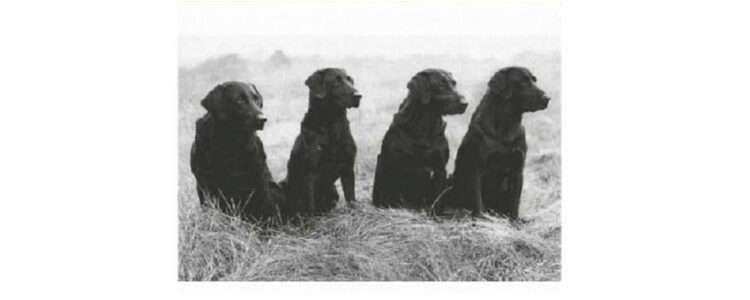
Not only one of 37 Labradors in the US to earn both a show and a field championship, but part of a dynasty. Four Dual Champions in four consecutive generations – 3xNFC CFC Dual CH Shed of Arden, father of Dual CH Grangemead Precocious, grandfather of Dual CH Cherokee Buck and great grandfather of Dual CH AFC Alpine Cherokee Rocket.
HIS BACKGROUND
Precocious was bred and owned by Thomas W. Merritt, a man who spent many years supporting the breed and competition he loved.
- Judged over 50 field trials, including the first National Amateur Stake in 1957 and the National Open (4 times).
- One of the original incorporators of the National Club.
- Past President of the Labrador Club.
- Was a Director of the American Kennel Club.
- President and Editor-in-Chief of the Retriever Field Trial News.
That’s in addition to breeding and owning some of the top Labs of the 1940s and 1950s. He reminds me of Lorna, Countess Howe in their efforts for the breed plus the great dogs they each owned.
Merritt mentioned one of his first puppies was Grangemead Angel who was sired by FC Freehaven Jay. Her mother was a granddaughter of Eng CH Banchory Trueman – another link to Lorna. He bred Angel to Am FC Eng FTCh Hiwood Mike who was a grandson of Eng Dual CH Banchory Painter, yet another link.
Grangemead Sharon, mother of Dual CH Cherokee Buck, was a puppy from the Angel x Mike litter.
HIS PEDIGREE
| 3xNFC CFC Dual CH Shed of Arden | CH Raffles of Earlsmoor | Thatch of Whitmore (Eng CCW) |
| Task of Whitmore (Eng CCW) | ||
| FC Decoy of Arden | Odds On (Eng FTW) | |
| Peggy of Shipton (Eng FTW) | ||
| Huron’s Lady | Am Eng CH Banchory Trump of Wingan | Blenheim Scamp (Eng FTW) |
| Lady Daphne | ||
| CH Bancstone Lorna of Wingan | Eng Dual CH Bramshaw Bob | |
| Eng CH Drinkstone Peg |
The Labrador Retriever was still pretty new to our shores at this time and all eight of Precocious’ great grandparents were British. Shed of Arden was sired by a British import and his maternal grandparents were both British imports. Precocious’ maternal grandparents were also British imports.
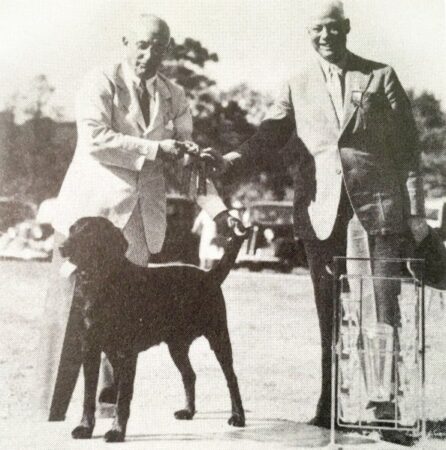
CH Raffles of Earlsmoor
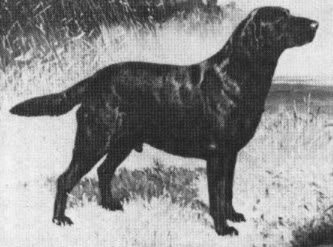
3xNFC CFC Dual CH Shed of Arden

FC Decoy of Arden (right)

Banchory Trump of Wingan
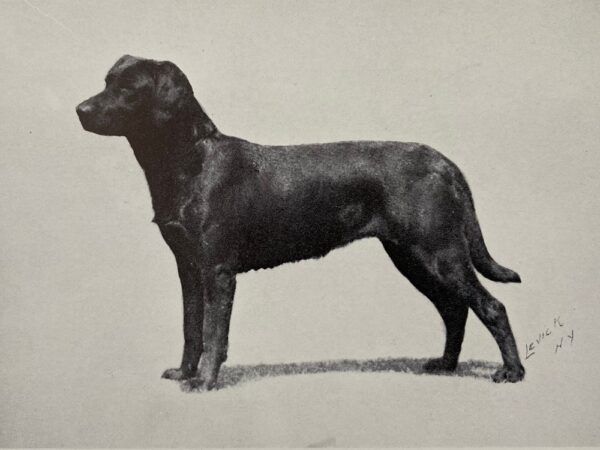
Bancstone Lorna of Wingan
PRECOCIOUS GETS HIS START
He was born June 21, 1946, along with at least two litter brothers, Jock of Athabaska and Deer Creek Black Ace. Both brothers finished their show championships.
Merritt remembers Precocious as “a bigger dog than Shed. He was a good marking dog, especially in water and especially strong in water triples.” According to Helen Warwick in The Complete Labrador Retriever.
He was trained and handled by Harold Berentsen. He won his first Open stake at 28 months and finished his field championship about a year later.
During the summer of 1950 he became a show dog and often won Best of Breed. He even placed in the Group a couple of times. Admittedly entries were much smaller than they are today. He won his first Best of Breed on May 7, 1950 and finished his show championship on June 18, 1950. Having already finished his field championship, he became a Dual Champion that same day.
He qualified for and ran in four National Championships – 1948, 1949, 1950 and 1951. He was a finalist in 1950 and 1951.
HIS LEGACY
Some people say he was named Precocious because he sired his first litter at the age of six or seven months. Based on birth dates, he was actually a grand old pup of nine months when he did the deed.
But what a deed! In that one litter with Grangemead Sharon he sired:
DUAL CH CHEROKEE BUCK
– sire of Dual CH AFC Alpine Cherokee Buck
— grandsire of NAFC FC Andy’s Partner Pete
– sire of Ironwood Cherokee Chica
— grandsire of NFC 2xNAFC Super Chief (Hall of Fame), FC AFC Carr-Lab Penrod, FC Chief Black Feather, FC AFC Paha Sapa Warpaint, FC AFC Paha’s Pow-Wow, Spring Farms Lucky QAA
– sire of Luscious Licorice Lass
— grandsire of FC AFC CFC Triple Echo
FC CHEROKEE MEDICINE MAN
FC FREEHAVEN MUSCLES
– sire of FC AFC Paha Sapa Chief II (Hall of Fame)
— grandsire of NFC 2xNAFC Super Chief (Hall of Fame), FC AFC Carr-Lab Penrod, FC Chief Black Feather, FC AFC Paha Sapa Warpaint, FC AFC Paha’s Pow-Wow, Spring Farms Lucky QAA
— grandsire of NAFC FC Rebel Chief of Heber (Hall of Fame) and AFC Jilly Girl
– sire of FC Nelgard’s Counter Point
— grandsire of Dual CH CFC Ridgewood’s Playboy and FC AFC Sand Gold Kim
You can see these boys in the header image – left to right – Grangemead Precocious, Freehaven Muscles, Cherokee Medicine Man and Cherokee Buck.
Unfortunately Grangemead Sharon was given away before her sons were able to prove themselves. Who knows if a second litter of Precocious x Sharon would have equaled or bested the first litter.
Other offspring:
– sire of CFC Highlander’s Buccaneer and CAN CH Highlander’s Diana
— grandsire of Can Dual CH Blyth’s Knave of Spades
– sire of Beautywood’s Creole Jane
— grandsire of Don’s Ginny Soo
— great grandsire of 2xNAFC 3xCNFC FC River Oaks Corky (Hall of Fame)
— grandsire of FC Roy’s Rowdy
And, yes, we have a bit of Precocious in our dogs. Our pretty Dee and all her offspring, including Arwen, Tory and Cotti, trace back to Precocious several times.
1 – Through 2xNAFC FC River Oaks Rascal to Beautywood’s Creole Jane to Precocious
2 – Through 2xNAFC FC River Oaks Rascal to Dual CH AFC Alpine Cherokee Rocket to Precocious
3 – Through Shamrock Acres Juego De Azar to FC Freehaven Muscles AND Dual CH Cherokee Buck to Precocious
4 – FC AFC Raider’s Piper Cub to FC AFC Paha Sapa Chief II to Precocious
5 – Timberlane Cinnamon to 2xNAFC 3xCNFC FC River Oaks Corky to Precocious
6 – Timberlane Cinnamon to Black Beauty of Random Lake to FC Freehaven Muscles to Precocious
7 – Timberland Cinnamon to Muscle Man of Random Lake to Rise and Shine at Duckwind to Precocious
8 – Timberland Cinnamon to Cherokee King Bojo to Precocious
9 – Timberland Cinnamon to Luscious Licorice Lass to Precocious
10 – FC AFC CFC Trieven Thunderhead to FC AFC Paha Sapa Chief II to Precocious
11 – FC AFC CFC Trieven Thunderhead to Ironwood Cherokee Chica to Precocious
12 – FC AFC CFC Trieven Thunderhead to AFC Jilly Girl to Precocious
13 – Dale’s Double Hope to Dual CH CFC Ridgewood Playboy to Precocious
14 – Dale’s Double Hope to FC AFC Serrana Sootana of Genesee to Precocious
15 – Dale’s Double Hope to FC AFC Toni’s Tar to Precocious
16 – Dale’s Double Hope to Ebony Sally of Widgeon Bay to Precocious
17 – Hard Driving Abigail to Cherokee King Bojo to Precocious (twice)
18 – Hard Driving Abigail to Luscious Licorice Lass to Precocious
And Chip too goes back to Precocious. Through Jilly Girl (twice), Beautywood’s Creole Jane (9x), Super Chief (twice), Gunfield’s Super Charger, Paha Sapa Chief II (separate from Super Chief) and Howmor’s Dark Gypsy.
DUAL CH Grangemeade Precocious
Whelped: June 21, 1946
Breeder: Thomas W. Merritt
Registration: S-127563
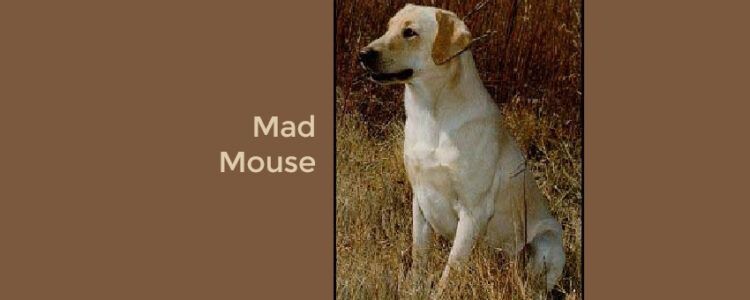
Mouse. What a name for a Labrador.
It’s memorable. Probably a good thing for a Hall of Fame dog.
I love the story of how Charlie and Yvonne Hays acquired him. They saw him in South Carolina when he was a young dog chasing fun bumpers. He beat his kennel mates to the bumpers and Charlie was so impressed he offered to buy him. The owner told him that he thought he was sold and the check should be in the mail.
So Charlie asked, “Mind if I check the mailbox?”
HIS HISTORY
Born on Christmas day in 1973, Candlewoods Mad Mouse qualified for and ran in his first National Open as a TWO year old. He was not yet titled, but made it to the seventh series handled by his owner. He finished both FC and AFC titles the following year.
He won a double header – winning both the Open and Amateur stake in the same trial.
He qualified for eight National Amateur trials and was a finalist in four. He also qualified for six National Open trials and competed in five. At the time of his death, he was the all-time high point yellow Labrador.
Mouse also ran field trials in Canada where he earned his CFC and CAFC as well.
In 1994 he was inducted into the Hall of Fame.
Mouse died in October 1984. He “… was known for his intelligence and his wagging tail. He was both a great field trial dog and a wonderful house pet.”
HIS PEDIGREE
| 2xNAFC FC River Oaks Rascal (Hall of Fame) | 2xNAFC 3xCNFC FC River Oaks Corky (Hall of Fame) | FC Martens Mister Nifty |
| Don’s Ginny Soo | ||
| Random Rapscallion | FC CFC Duxbak Scooter (Hall of Fame) | |
| Random Shot | ||
| Shamrock Acres Duck Soup | NFC 2xNAFC Super Chief (Hall of Fame) | FC AFC Paha Sapa Chief II (Hall of Fame) |
| Ironwood Cherokee Chica | ||
| Shamrock Acres Smoke Screen | NFC FC Marten’s Little Smoky | |
| Shamrock Acres Starlight |
Mouse was inducted into the Hall of Fame, as were his father, both grandfathers and two of his great grandfathers. Also four of the dogs in his three-generation pedigree were National Champions, some winning multiple times.
His Father
2xNAFC FC River Oaks Rascal
Hall of Fame
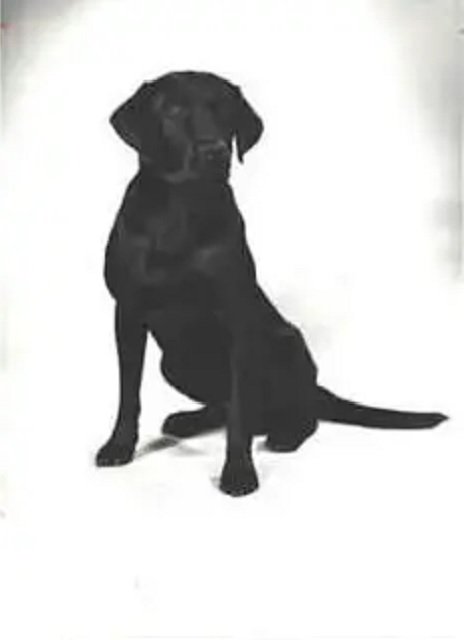
His Paternal Grandfather
2xNAFC 3xCNFC FC River Oaks Corky
Hall of Fame
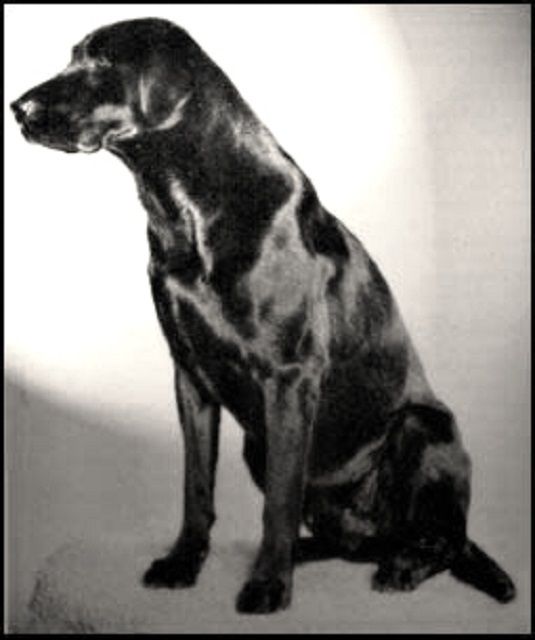
His Maternal Grandfather
NFC 2xNAFC Super Chief
Hall of Fame
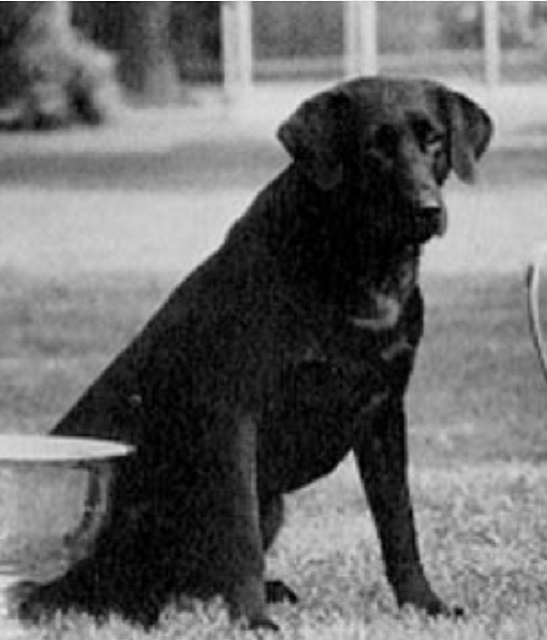
By the way, for those of you who know I’m fascinated with the DUAL CHAMPIONS, here’s who shows up just a bit farther back in Mouse’s pedigree.
- Martens Mister Nifty was a great grandson (and great great grandson) of Can DUAL CH Coastal Charger of Deer Creek.
- Don’s Ginny Soo was a granddaughter of DUAL CH Grangemead Precocious (by 3xNFC CFC DUAL CH Shed of Arden).
- Random Shot was sired by DUAL CH AFC Alpine Cherokee Rocket (by DUAL CH Cherokee Buck by DUAL CH Grangemead Precocious by 3xNFC CFC DUAL CH Shed of Arden).
- Paha-Sapa Chief was a grandson of DUAL CH Grangemead Precocious (by 3xNFC CFC DUAL CH Shed of Arden).
- Ironwood Cherokee Chica was sired by DUAL CH Cherokee Buck (by DUAL CH Grangemead Precocious by 3xNFC CFC DUAL CH Shed of Arden). And she was out of a granddaughter of Can DUAL CH Coastal Charger of Deer Creek.
- Marten’s Little Smoky was a great grandson of DUAL CH Grangemead Precocious.
- Shamrock Acres Starlight was a grand daughter of DUAL CH Dela-Winn’s Tar of Craignook (a little known DC).
Although not a DUAL CH, Duxbak Scooter’s grandmother was Eng Can CH Sandylands Jilly who is also an ancestor of Ebonstar Lean Mac (among others).
HIS OFFSPRING
- FC AFC Hellda Dolly (ex Ishtar’s Raider)
- AFC Kizzie of Southern Comfort (ex Agassiz Shores Coli-Ann CD)
- AFC CAFC Minnie Mouse (ex Belmars Black Castle) When Minnie was bred to AFC Westwinds Pedro, they produced CNFC CNAFC FC AFC The Marathon Man (Hall of Fame).
Mouse’s line continues through yet another daughter, BJ’s Crystal Light Brigade (out of BJ’s Dawn of Early Morning, a show-bred bitch of mostly Shamrock Acres breeding). And their daughter, Floodbay’s Caramel Crystal WCX (by FC AFC CNAFC CFC Gunstock’s Caramel Crunch) and their daughter, Clubmead’s Dark Crystal JH (by FC AFC CFC CAFC DB’s Cracker of Club Mead). Dark Crystal, better known as “Raven,” was a dog I owned. When bred to BISS Am Mex CH GMHR Cook’s Midnight Bandit MH, she produced Justamere Canis Major JH and Justamere Catalyst RA CGC CC. Many more dogs descend from these two littermates.
Another link to Mouse is through his 3/4 brother, FC AFC Canis Major’s River Bear. Bear was also sired by Rascal and out of a daughter of Super Chief. In turn, he was the sire of FC AFC River Oaks Way-Da-Go Rocky who figured prominently in our early dogs, including Arwen, Tory and Cotti, through his daughter Dee.
FC AFC CFC CAFC Candlewoods Mad Mouse
Yellow Labrador male
Breeder: Mary Howley (Candlewood)
Owner: Charlie and Yvonne Hays
Born: Dec 25, 1973
Died: Oct 1984
Registration: SB538973
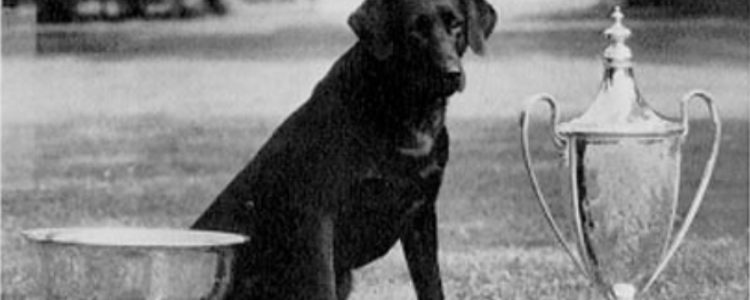
What makes a great dog? Is it genetics? Is it the way he’s raised? Is it due to training? Is it due to handling? Or is it all of the above? NFC 2xNAFC Super Chief would probably say all of the above.
SUPER CHIEF’S FORMULA FOR SUCCESS
Born in 1962, Soupy was given to August “Augie” Belmont IV by his breeder because a previous dog from the breeder had turned out unsound. The Belmonts raised Soupy on Long Island until he was six months old.
Training Greatness
At that time, Soupy was old enough to begin serious training, so Augie flew him to Rex Carr in California. Carr is called “the father of modern retriever training.”
To be trained by a legend would definitely help a dog achieve greatness.
Handling Expertise
Rex Carr often trained the owners to handle their own dogs – a task that’s probably more difficult than training the dogs. It must have worked though as Augie and his wife, Louise, handled Soupy to many field trial wins. Starting with five Derby wins by 19 months, Soupy won 40 Derby points, 112 Amateur points and 242 Open points. He also won the 1967 and 1968 National Amateur Retriever championship plus the 1968 National Retriever championship.
Soupy had a good trainer and good handlers.
Superb Genetics
What about genetics? His parents were both grandchildren of DUAL CH Grangemead Precocious. Precocious was sired by 3xNFC CFC DUAL CH Shed of Arden out of Huron’s Lady – a mixture of show, field and dual champions.
Add in two crosses each to:
- Am Eng FC Hiwood Mike
- DUAL CH CFC Little Pierre of Deer Creek
- NFC AFC Marvadel Black Gum
- Can DUAL CH Coastal Charger of Deer Creek
Plus NFC AFC CFC Cork of Oakwood Lane and NFC Tar of Arden.
Plus more Dual Champions – DUAL CH Cherokee Buck and DUAL CH NFC CFC Bracken’s Sweep.
Plus a line that includes dogs from the Sandylands show kennel through FC The Spider of Kingswere.
| FC AFC Paha-Sapa Chief II | FC Freehaven Muscles | DUAL CH Grangemead Precocious |
| Grangemead Sharon | ||
| Treasure State Bewise *** | FC The Spider of Kingswere | |
| FC Deer Creek’s Bewise | ||
| Ironwood Cherokee Chica | DUAL CH Cherokee Buck | DUAL CH Grangemead Precocious |
| Grangemead Sharon | ||
| Glen-Water Fantom | NFC AFC CFC Cork of Oakwood Lane | |
| Little Peggy Black Gum |
Click to see his 5-generation pedigree.
DESCENDANTS
Soupy was bred to a variety of bitches, some with field breeding, but also to some with show breeding. Between his pedigree and his offspring, I’d say he also had good genetics.
Some of his offspring include:
* DUAL CH Shamrock Acres Super Drive
Sire of Am Mex CH Gunfield’s Super Charger CD WC who did much to improve chocolates
* DUAL CH Royal Oaks Jill of Burgundy 2005 Hall of Fame
* NFC NAFC 2xCNFC Wanapum Darts Dandy 1992 Hall of Fame
* FC AFC Air Express
Sire of many field champions, including FC AFC Itchin’ To Go, CNFC FC Overland Express, FC AFC CFC Trieven Thunderhead, FC AFC CFC CAFC Wanapum Super Sioux, NAFC FC Winsom Cargo and DUAL CH AFC Trumarc’s Triple Threat
* FC AFC Candlewood’s Nellie B Good
Granddam of FC AFC Wilderness Harley To Go 2003 Hall of Fame and FC AFC Candlewoods M D Houston 1996 Hall of Fame
* NFC FC AFC Euroclydon (pronounced u-roc-li-don)
1993 Hall of Fame and dam of NFC FC AFC Orion’s Sky 1994 Hall of Fame
* FC Candlewood’s Super Deal
Grandsire of 3xNFC FC AFC Candlewood’s Tanks A Lot
* Super Powder QAA
Sire of NFC AFC FTCH Risky Business Ruby 1993 Hall of Fame and FC AFC Volwood’s Ruff And Reddy 2000 Hall of Fame plus grandsire of FC AFC Code Blue 2000 Hall of Fame and FC AFC CNFC CAFC Chena River No Surprise 2004 Hall of Fame
* Shamrock Acres Juego de Azar
Granddam of FC AFC River Oaks Way-Da-Go Rocky who was the sire of our Knight’s Tail Dehlia.
* Shamrock Acres Super Sioux
Dam of FC AFC Raider’s Piper Cub
* Sirion’s Super Snooper
Dam of CFC Rascal’s Super Spud who sired CNFC CNAFC Waldorf’s High Tech who sired 2xNAFC 2xCNAFC FC CFC Ebonstar Lean Mac
* Paha Sapa Greta
Dam of FC AFC Ironwood Tarnation 1995 Hall of Fame
* Cup A Soup
Dam of NFC AFC CFC CAFC Yankee Independence
* FC Shamrock Acres Super Value 1998 Hall of Fame
* Shamrock Acres Duck Soup
Dam of FC AFC CFC CAFC Candlewoods Mad Mouse 1994 Hall of Fame
* FC Wanapum Sheba
Dam of NAFC FC Kannonball Kate 1992 Hall of Fame
And several more titled offspring.
Is Soupy in our pedigrees? Yes, many times.
- Chip and all of his descendants trace to him through DUAL CH Shamrock Acres Super Drive (12 times!) and CH Gunfields Super Charger CD, DUAL CH Trumarc’s Triple Threat, FC AFC Air Express, FC AFC CFC Trieven Thunderhead, FC AFC Candlewood’s Nellie Be Good, CH K’s Jetta of Someday, AFC Shamrock Acres Whiskey Jake
- Dee and her descendants trace to him through FC AFC Canis Major’s River Bear
- Cat and her descendants trace to him through 2xNAFC 2xCNAFC FC CFC Ebonstar Lean Mac, CNFC CNAFC FC AFC The Marathon Man, FC AFC CFC CAFC Candlewoods Mad Mouse (twice) and NFC FC AFC Westwind Supernova Chief
By the way, if you follow horse racing you’ll recognize the family name. Although Augie also owned race horses, he was not as active as his grandfather, August Belmont II, or great grandfather, August Belmont, who founded Belmont Park and for whom the Triple Crown race was named.


